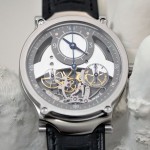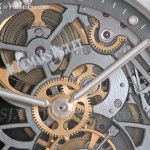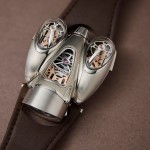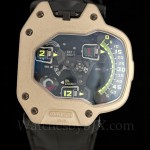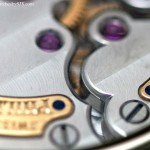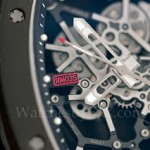Up Close: Sylvain Pinaud Origine
Restrained, subtle, and impressively executed.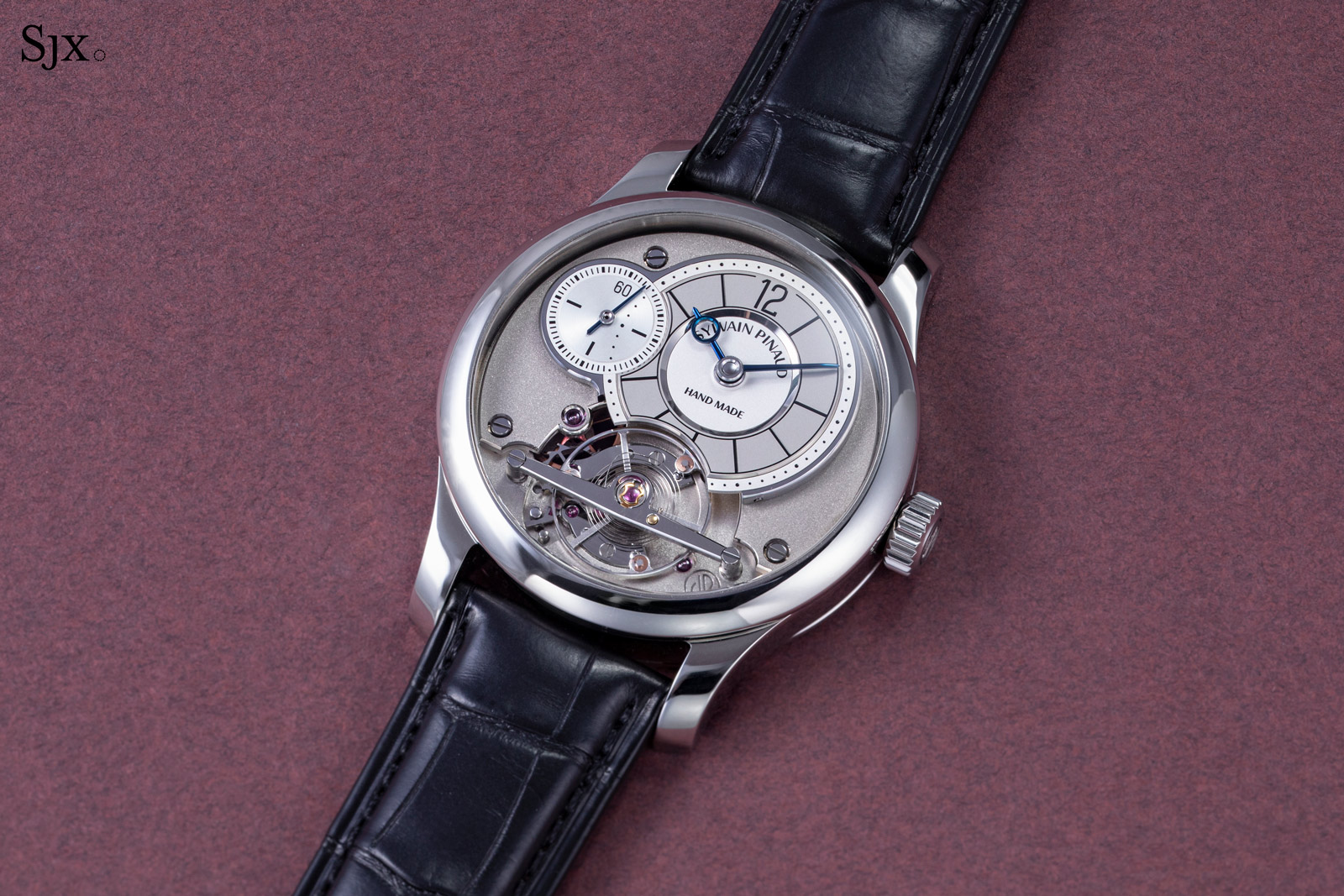
Sylvain Pinaud entered the independent watchmaking stage in 2019 when he revealed his monopoussoir chronograph that had an unusual dial-side mechanism and a high level of decoration. But he was working on something both more concise and more elaborate all along, the Origine.
Launched earlier in 2022, the Origine is a wristwatch that pursues a familiar formula in independent watchmaking – a time-only movement finished extremely well and mostly made by the watchmaker himself, except for the dial and case that are the work of an industry favourite. But Mr Pinaud does it better than most with an original movement construction and gorgeous decoration, though he is clearly still perfecting his brand’s defining aesthetic.
NB: The watch pictured is the prototype of the Origine so it is slightly imperfect in terms of cleanliness and detailing.
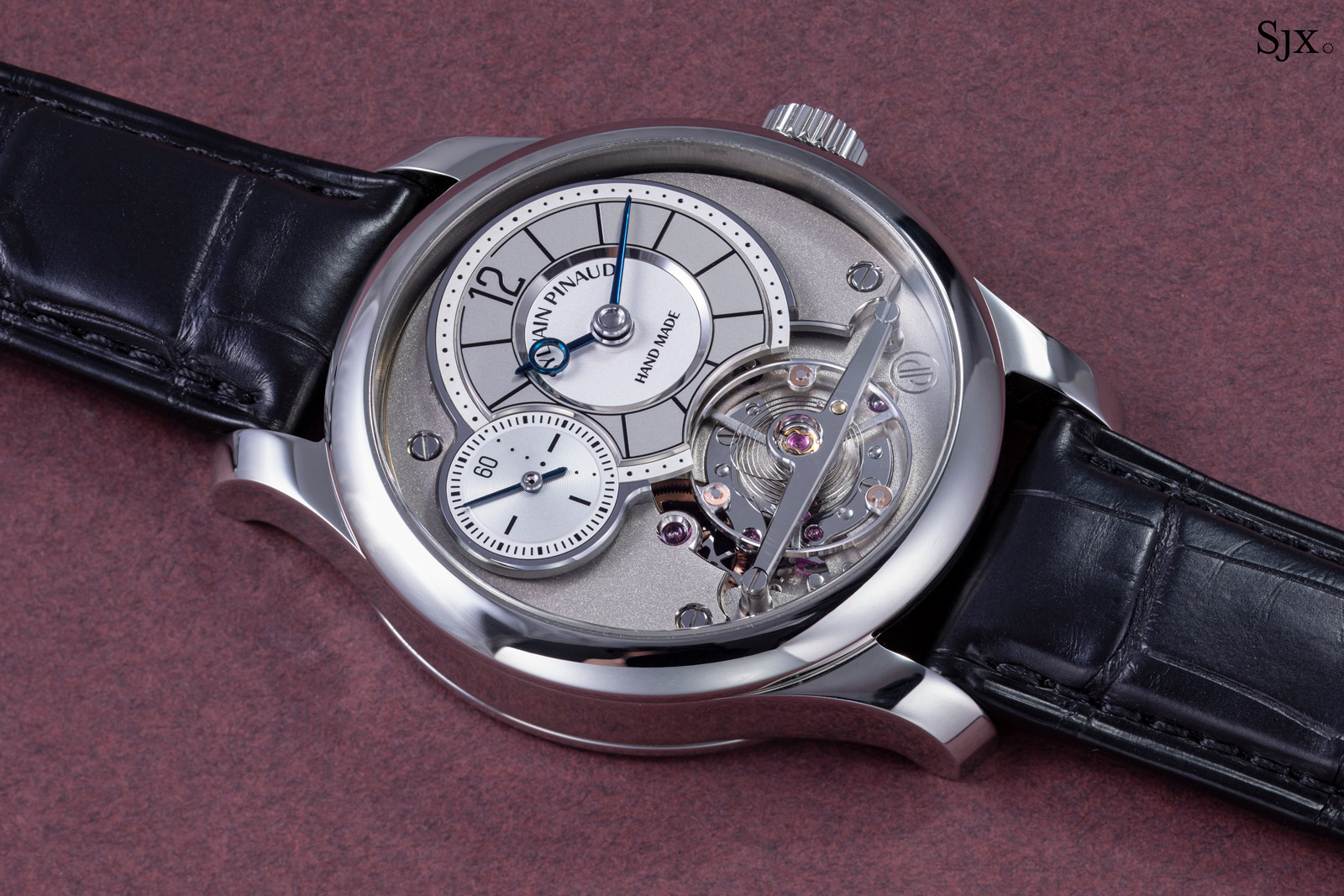
Initial thoughts
At first glance, the Origine might seem like one of many time-only rolled out by watchmakers who recently set up their own brands. But it stands apart in several aspects.
For one, Mr Pinaud is an experienced watchmaker unlike many nascent independent watchmakers. Now in his forties, he graduated from watchmaking school in 1998 before embarking on a career that took him to Franck Muller as well as Carl F. Bucherer.
And then there’s the quality of execution, which is extremely high. Not only is the movement an original construction by Mr Pinaud himself, the decoration is top class.
In fact, a major part of the Origine’s visual appeal is not so much the design but the quality of execution. The polished, frosted, and otherwise grained components catch the light and gleam, even at arm’s length.
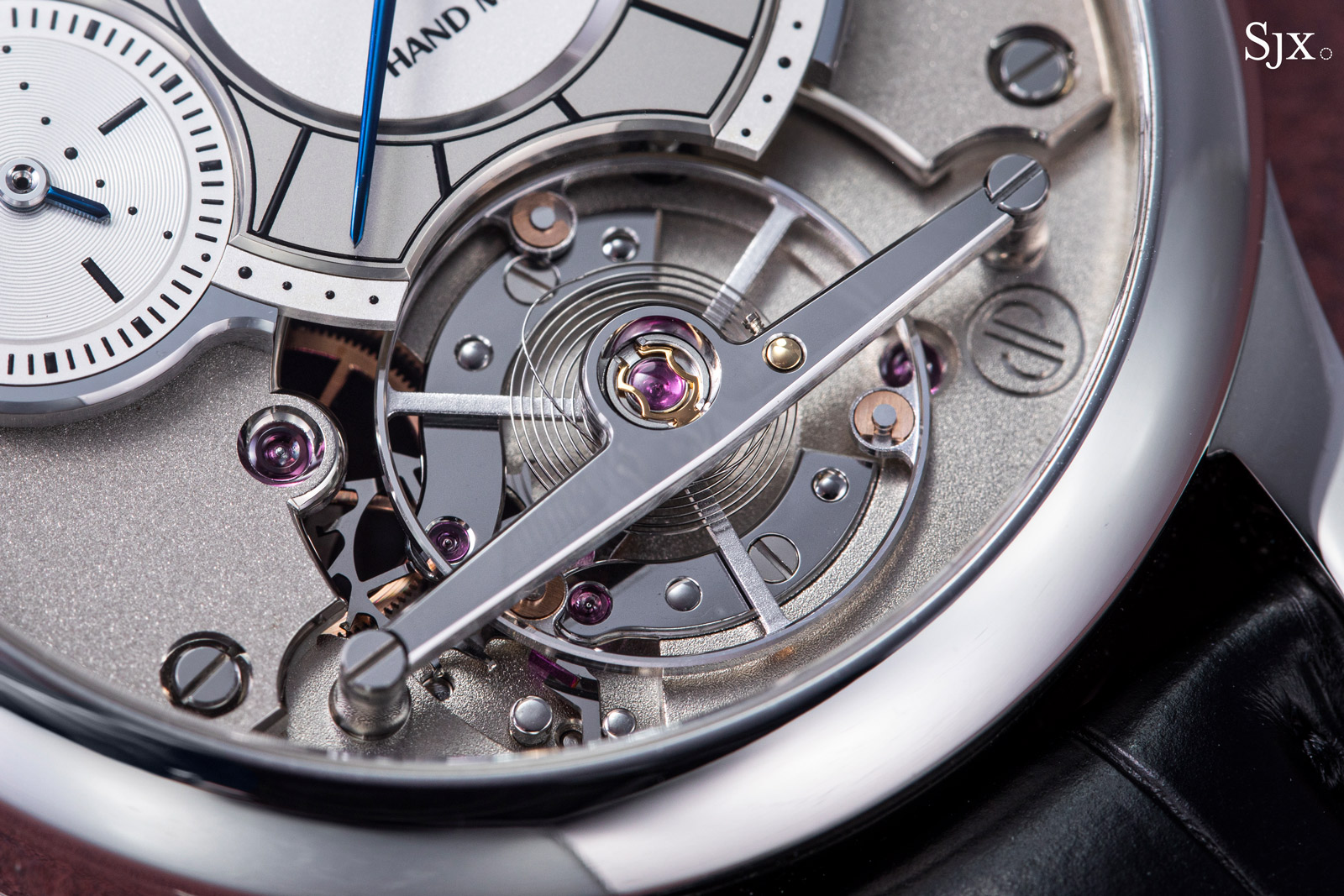
Quality aside, the design is ordinary. The Origine is clean and handsome, and also clearly modern, in contrast to say, the Yosuke Sekiguchi Primevere launched at almost the same time, which sets out to reproduce the look of a 19th century pocket watch. There are also hints of other brands in the look, most notably Greubel Forsey in the dial and F.P. Journe in the case.
The muted aesthetic character of the Origine doesn’t quite live up to the tangible aspects of the watch. That’s especially so in the case of the prototype, which has an almost monochromatic silver and white livery.
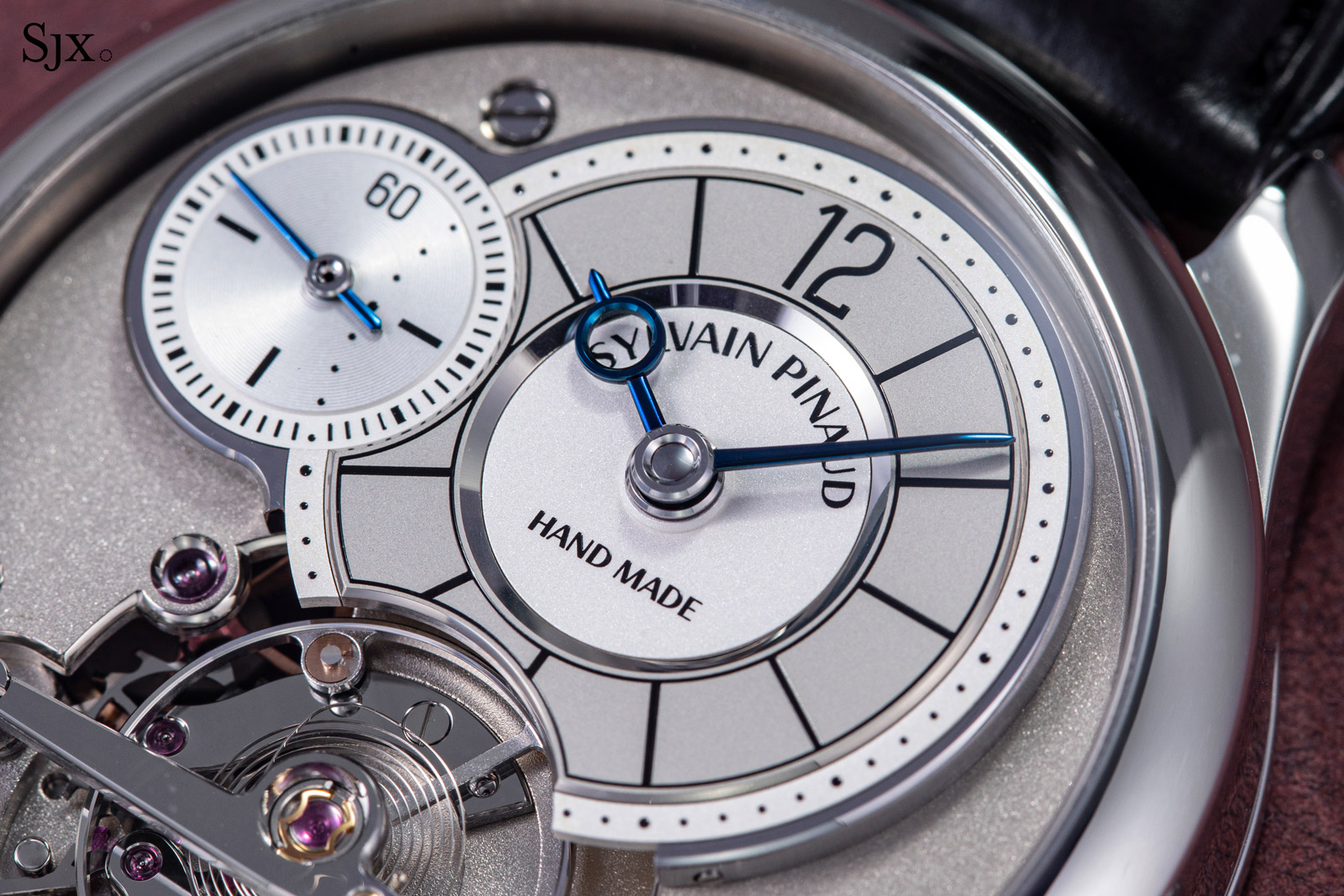
Over on the back, the quality is equally good – the finishing is impeccable – and there’s more to admire with the steel wheels and finger bridges. But a key element of the design can be improved in my opinion: there’s a peculiar gap where the balance wheel would otherwise be.
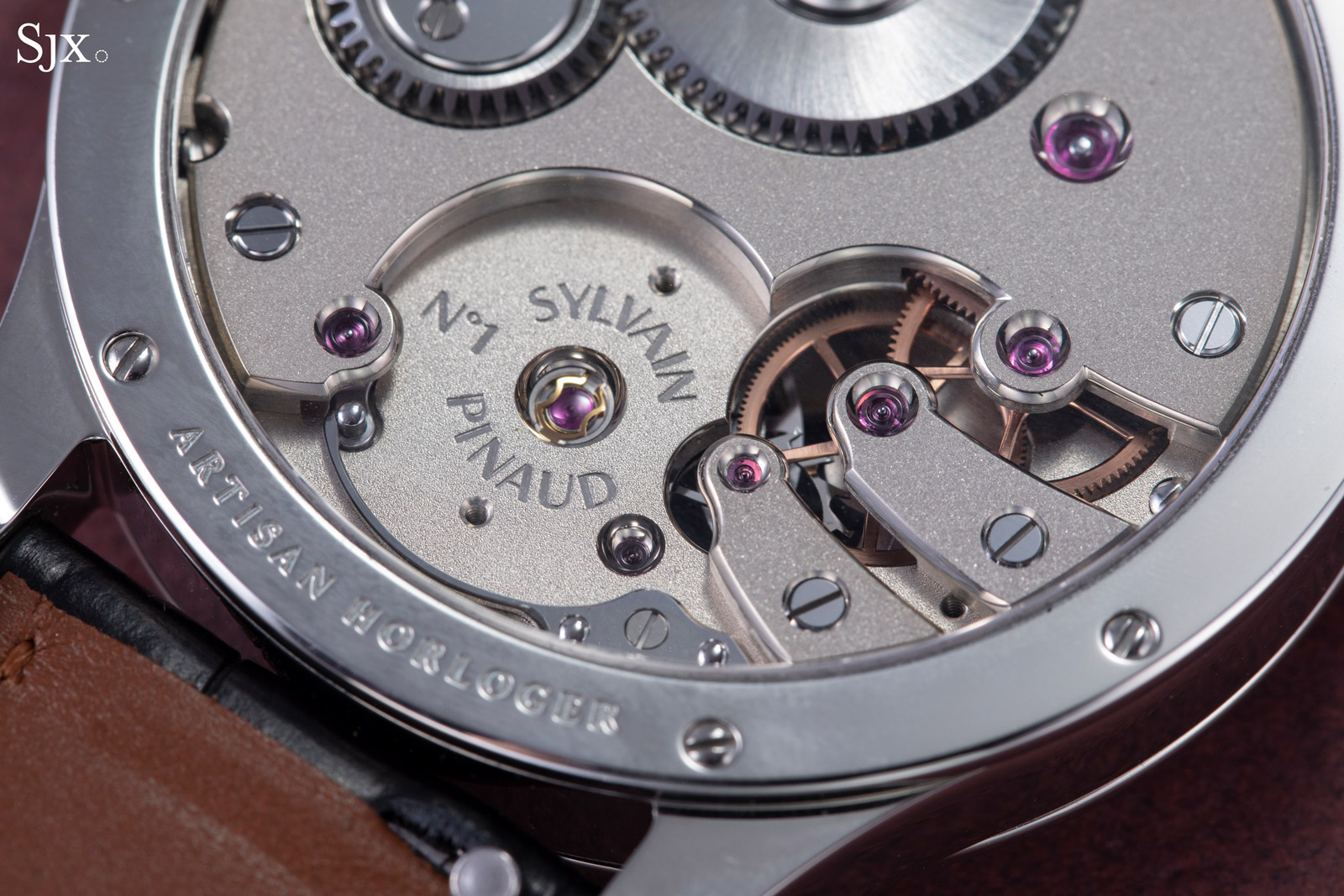
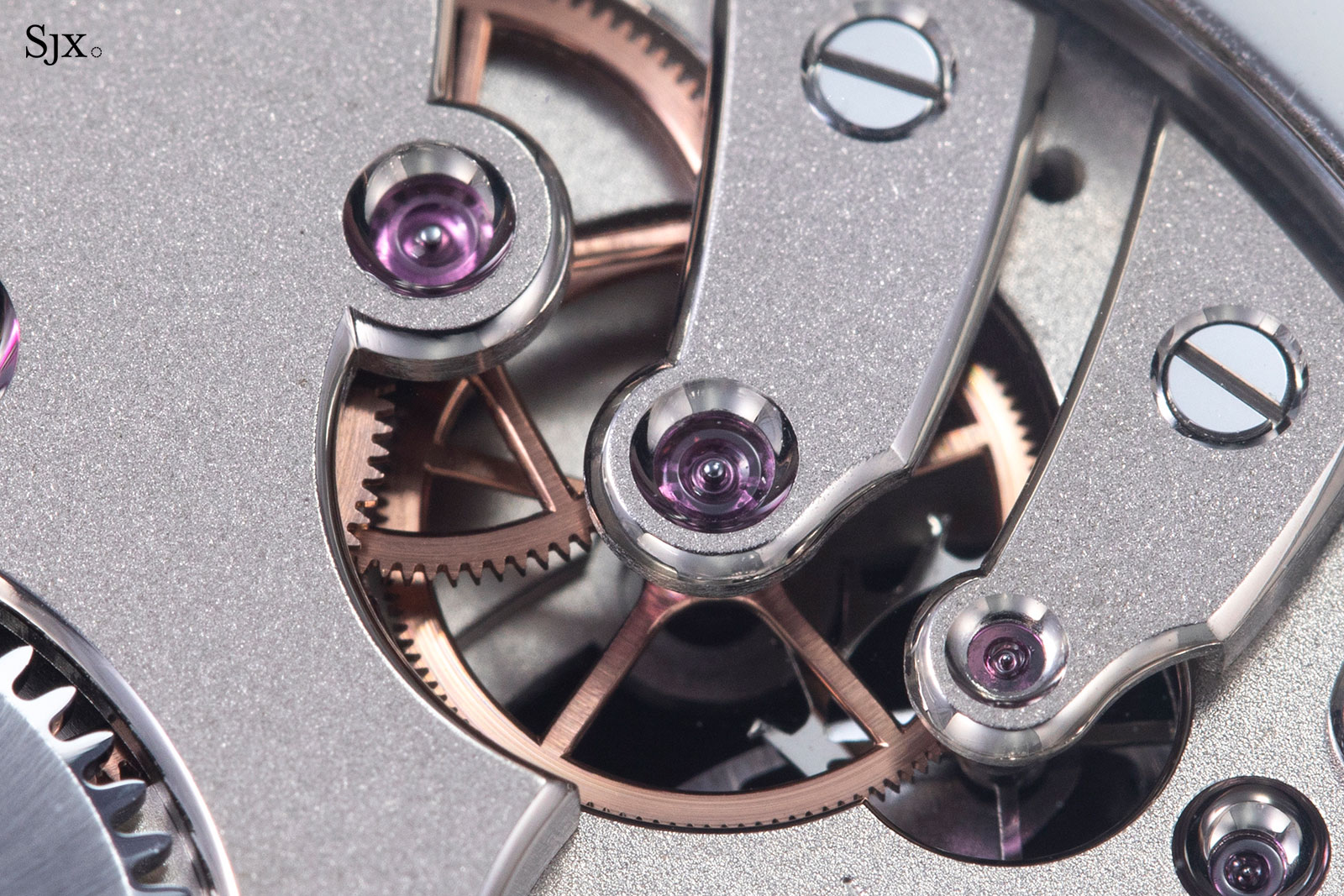
The bridges for the going train
The Sylvain Pinaud brand arguably has no house style yet, with his earlier chronograph appearing vastly different from the Origine. But it is probably a matter of time that Mr Pinaud sharpens his design – Mr Pinaud has only been at this for three years and he is no doubt still in the process of defining his brand’s style.
Considering its tangible quality, the Origine is certainly one of the impressive debuts from a new entrant. Costing CHF65,000 with a steel case, it is priced comparably to similar watches, making it a reasonable proposition in terms of value.
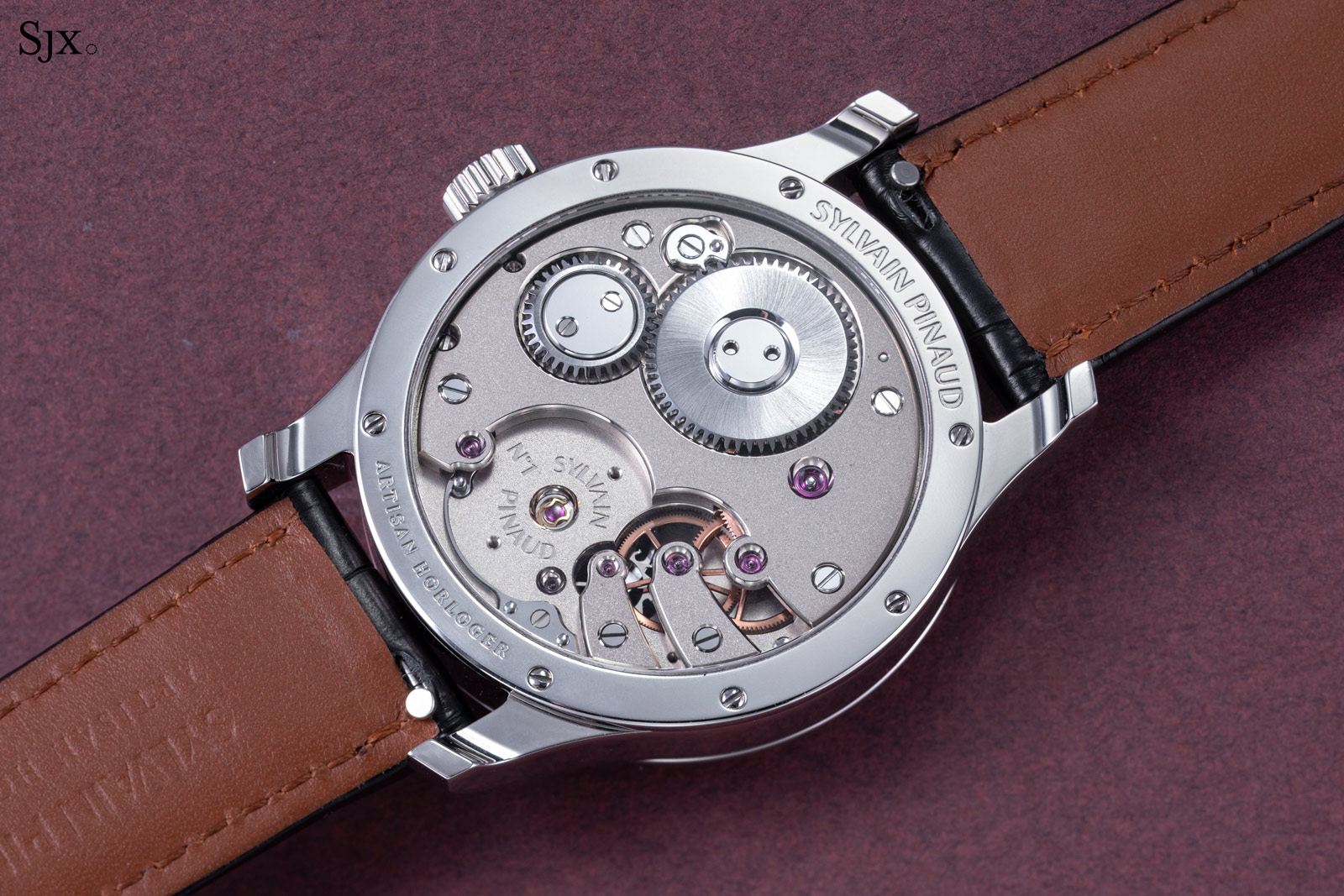
Origins
French by birth and education, Mr Pinaud has worked in Switzerland since 2003 as both a restorer of antique timepieces as well as a prototype maker, taking the time to acquire the skills and knowledge needed to create his own watches.
In 2018 he set up his own workshop in Sainte-Croix, the home of his last employer, Carl F. Bucherer, and announced his first watch a year later. It was a singe-button chronograph based on an ETA Unitas ebauche that won him a prestigious craftsmanship prize bestowed by the French government.
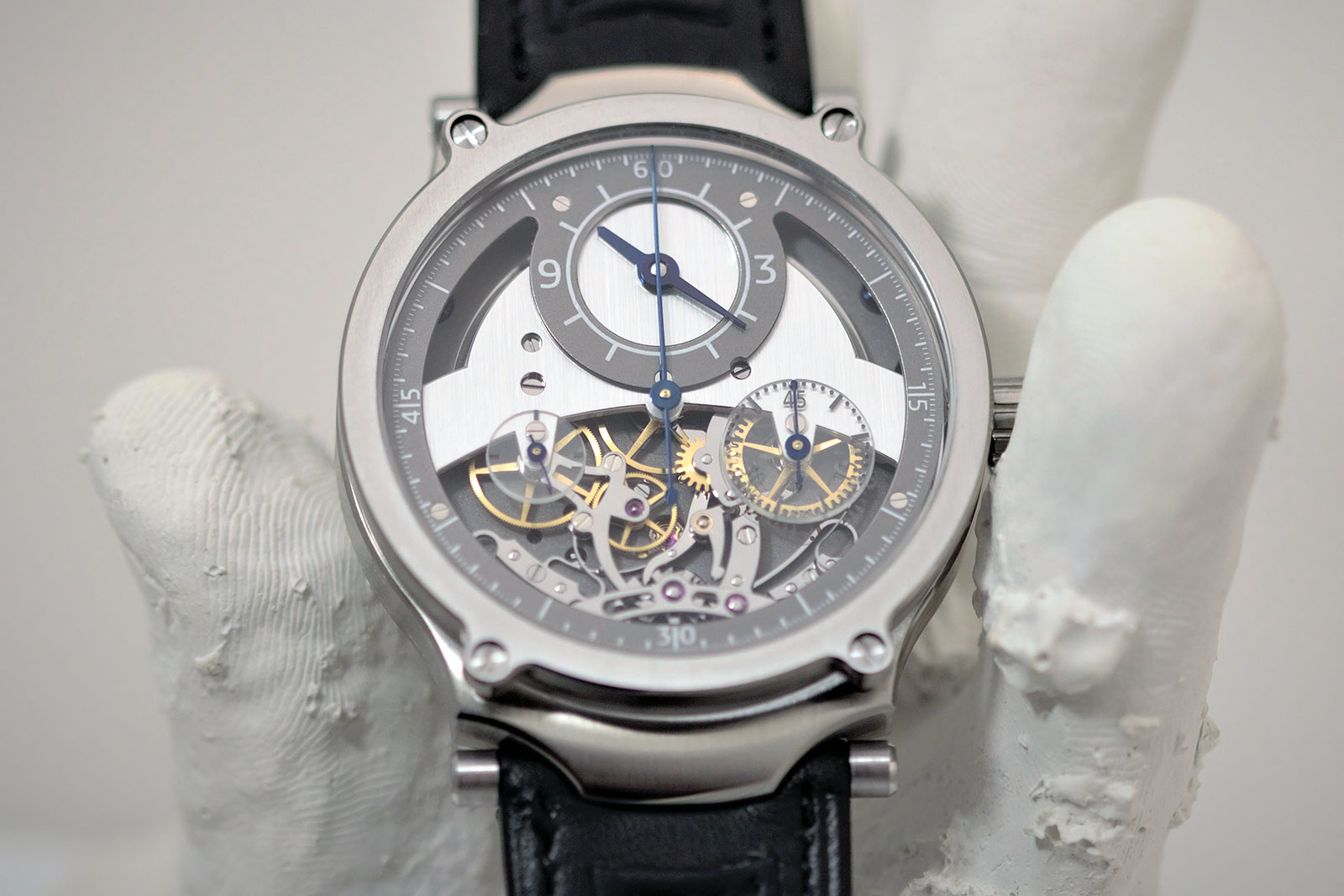
Mr Pinaud’s chronograph. Image – Sylvain Pinaud
Though it was only launched earlier this year, Origine has been a work in progress since Mr Pinaud struck out on his own. Simpler than the chronograph, the Origine is nonetheless a more sophisticated and original creation. Mr Pinaud designed both the movement and case himself with CAD software. That includes the calculations for the going train and escapement, all of which are specific to the Origine.
Now comprised of him and an assistant who recently joined, Mr Pinaud’s workshop produces almost all of the watch using with automated CNC mills as well as manually-operated lathes and jigs. He only turns to suppliers for the components that are typically outsourced, namely the hairspring, jewels, mainspring, case, and dial. And like a number of independent watchmakers, he turned to Comblemine for the dial.
Because he makes most of the watch himself, Mr Pinaud can replace the steel bridges and blue steel hands that are pictured here with the same but in 18k rose gold, for a modest premium of CHF3,000.
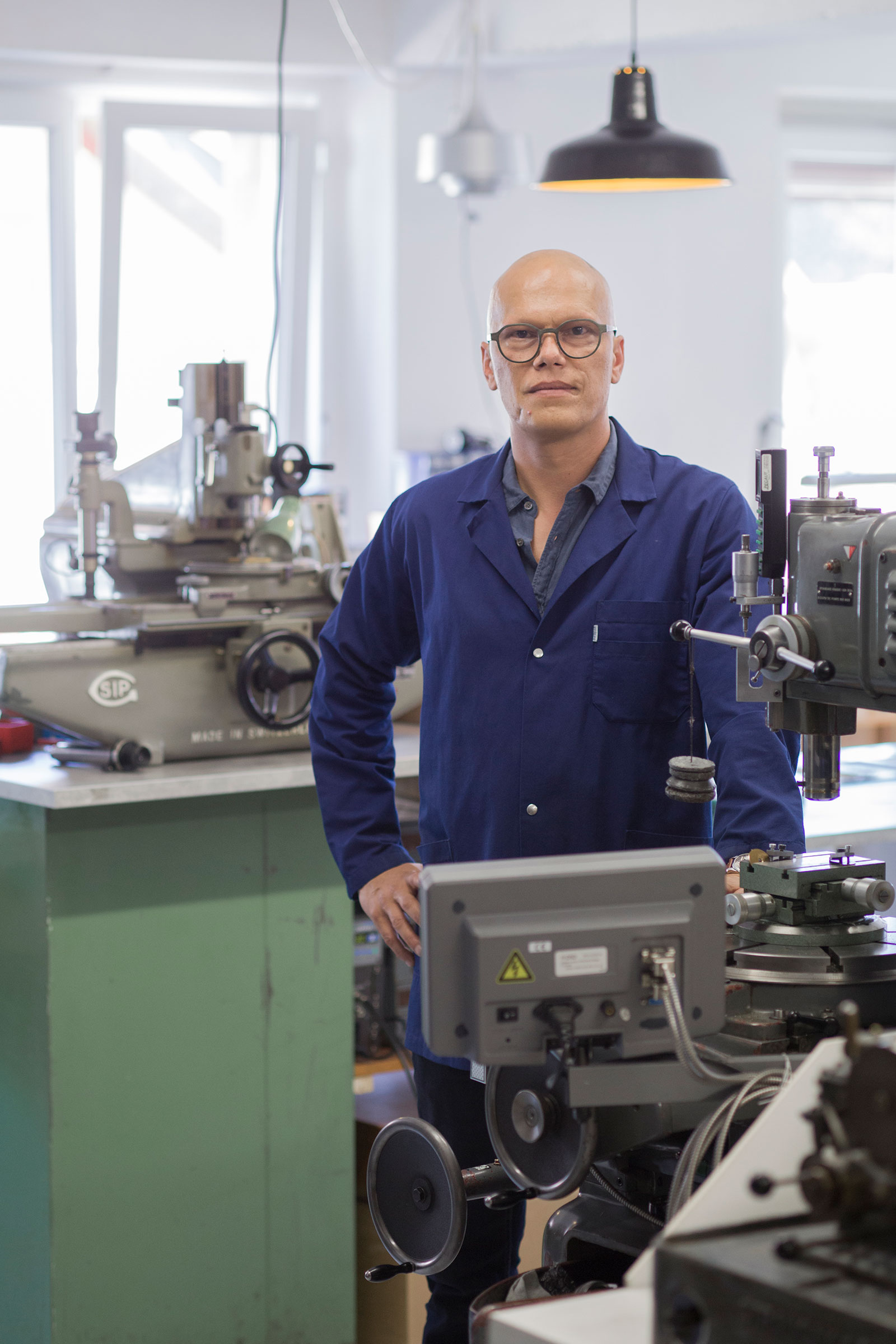
Mr Pinaud in his workshop. Image – Sylvain Pinaud
Clean lines
Typical of many watches in this genre, the Origine is modestly sized at 40 mm by 11 mm, large enough to have presence but not too big. The form of the case, namely the domed bezel and wide lugs, also makes it seem slightly larger than it is, which isn’t a bad thing given its moderate size.
There’s a hint of F.P. Journe in the case design, though the Origine is heftier with its thicker bezel and lugs. That said, the case design is simple enough that it doesn’t look like a copy of something else.
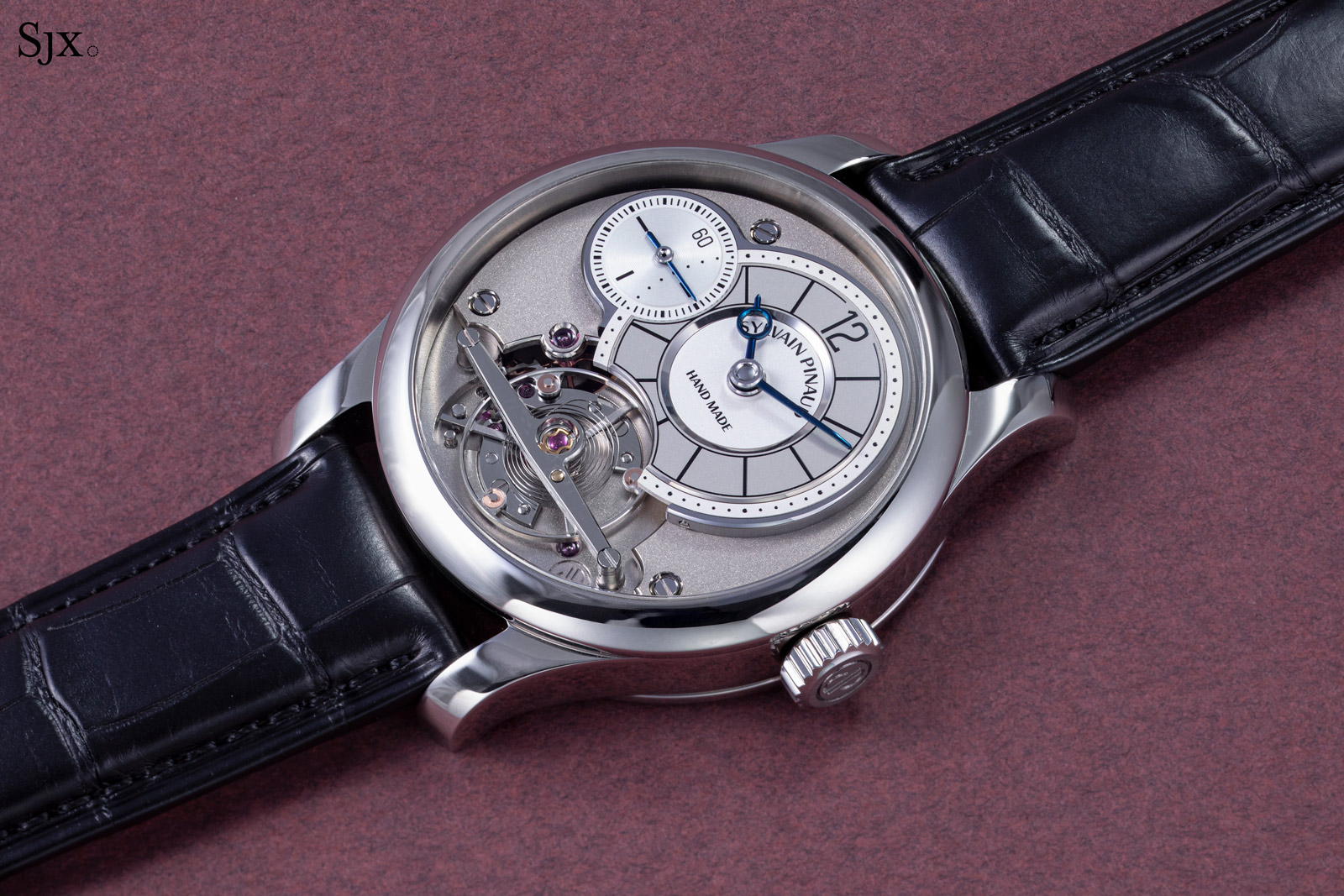
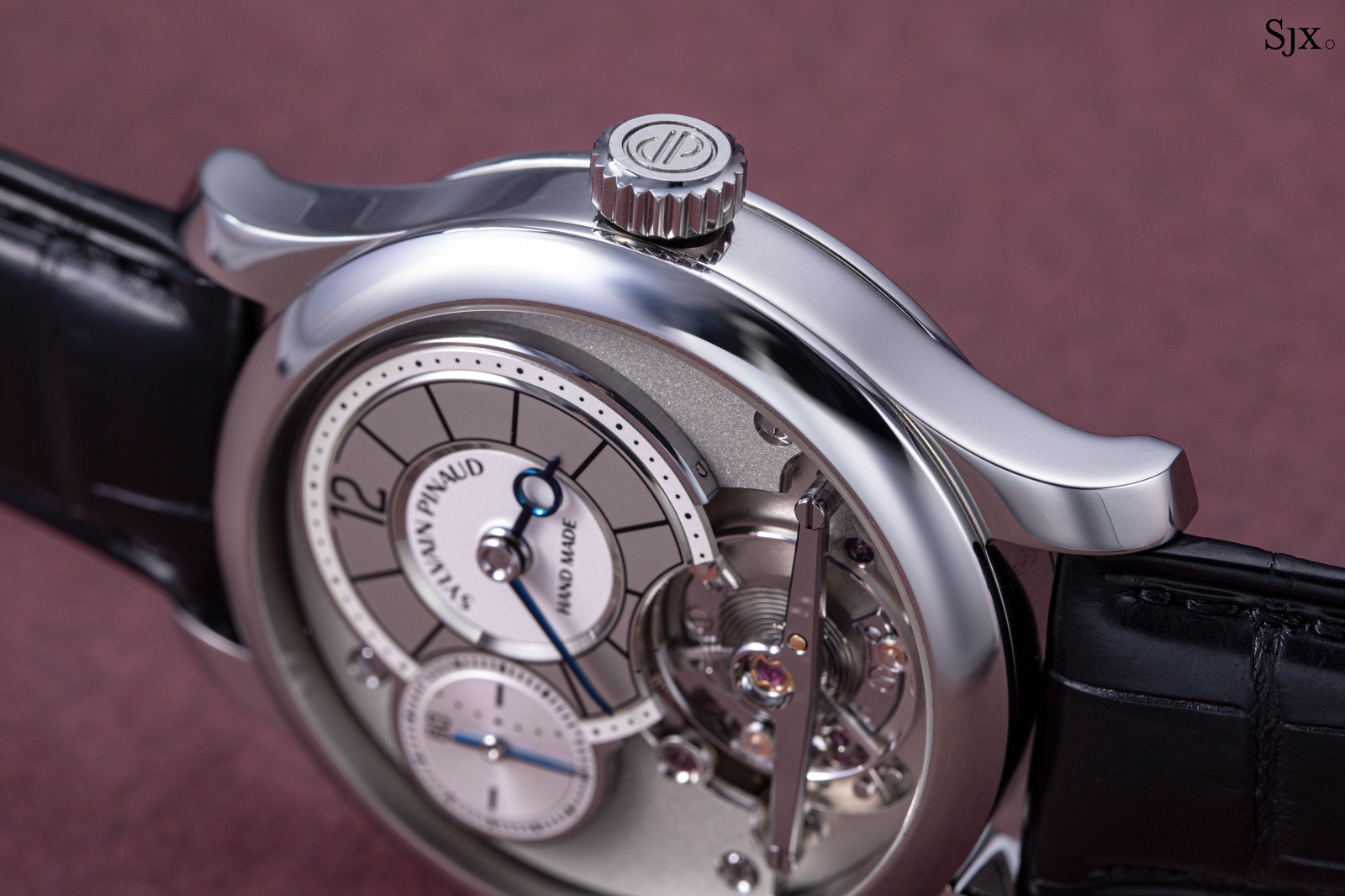
Entirely mirror polished and cleanly styled, the case is basic in appearance but evidently high quality. The polished surfaces of the lugs and sides, for instance, are consistent and flat. That’s unsurprisingly given that it’s produced by Voutilainen & Cattin, the case maker part-owned by Kari Voutilainen.
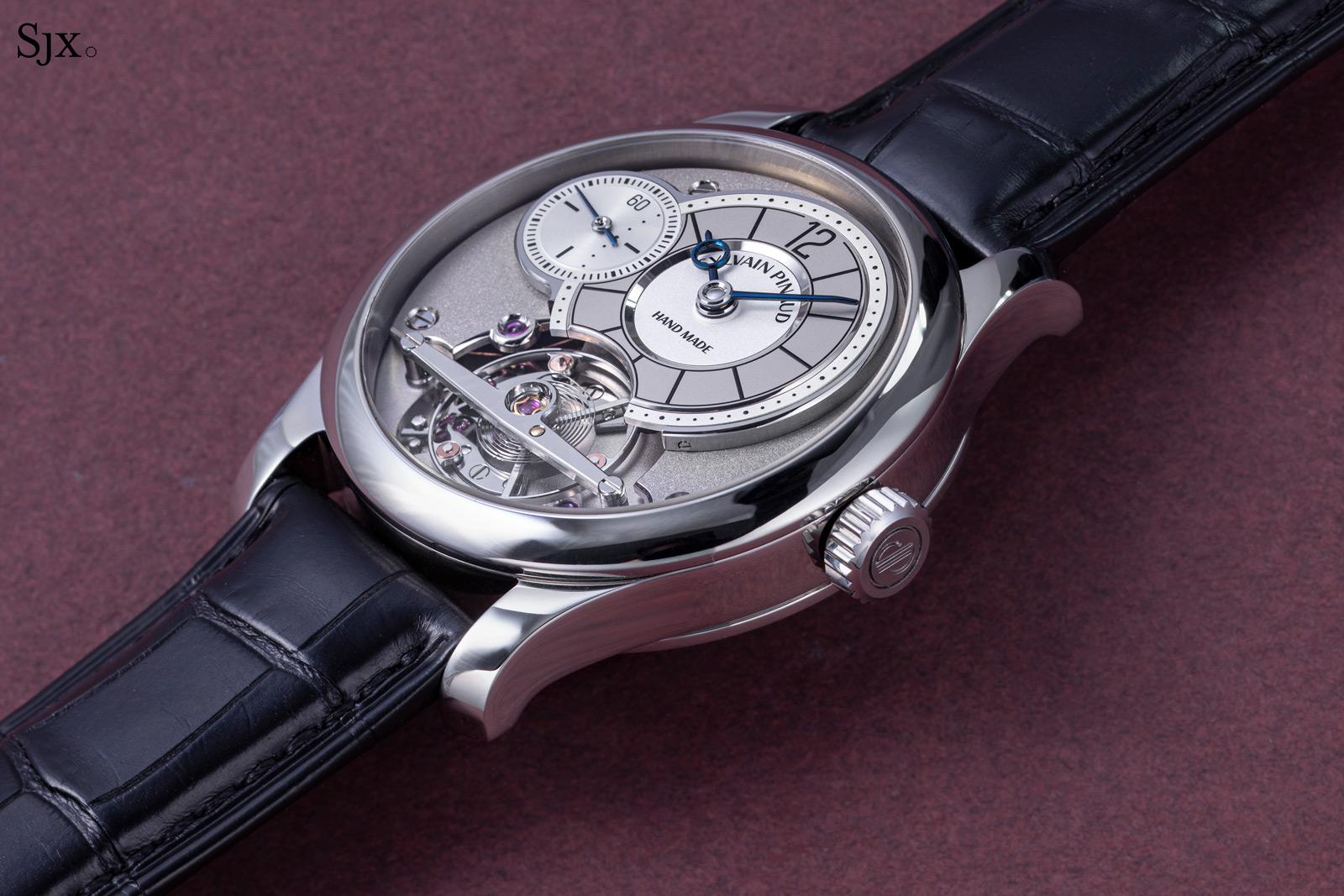
Elevated balance
The Origine movement is unconventional in construction – the balance and escapement have been relocated from their usual position on the back to the dial. Granted, the exposed balance is a popular form of expression for independent watchmakers so it’s not unique, but it still looks good, particularly with Mr Pinaud’s excellent finishing.
Since it takes pride of place on the dial, the balance assembly should be dressed up and it fortunately it doesn’t disappoint.
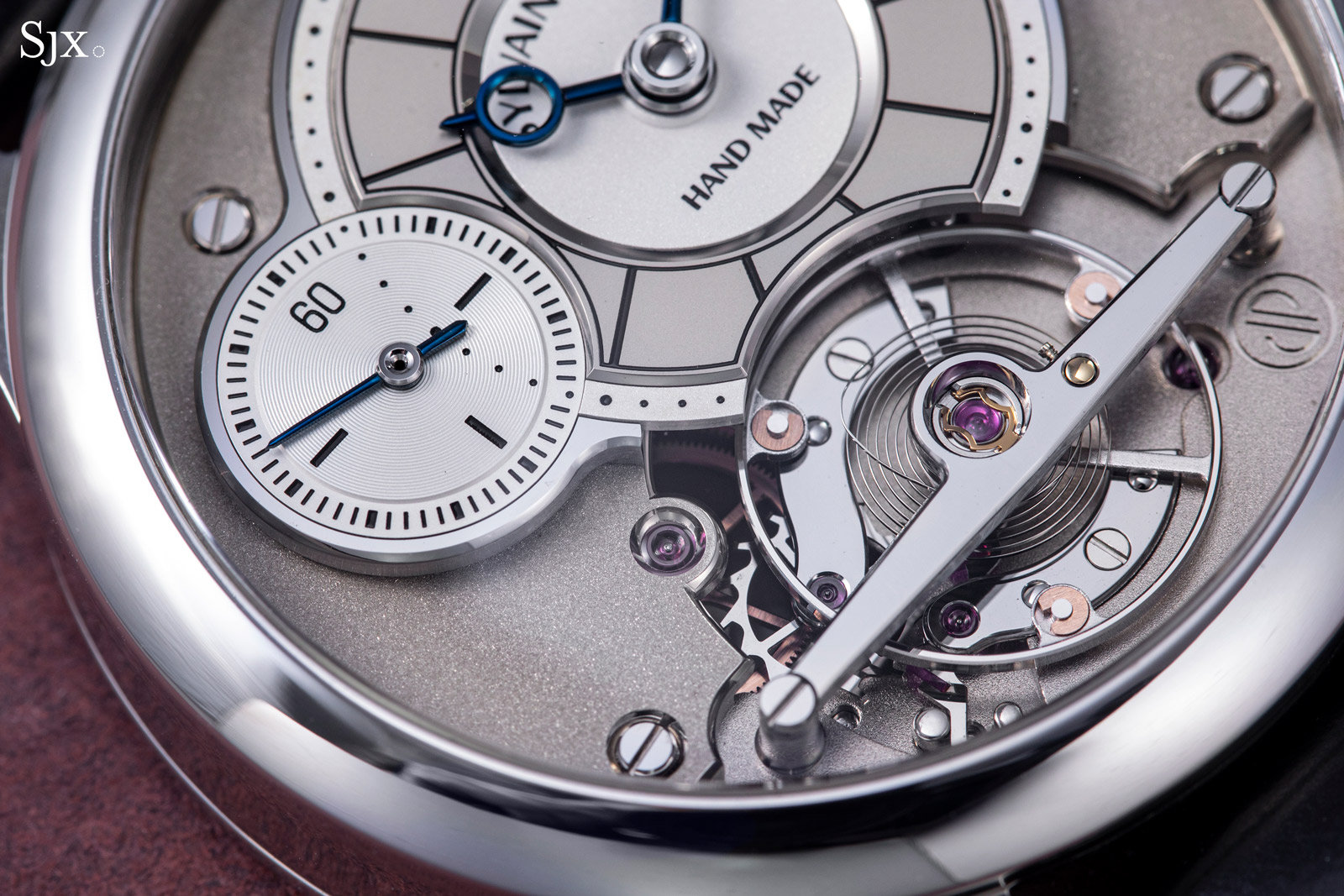
Three armed and free sprung, the balance wheel is of Mr Pinaud’s own design and attractively symmetrical. The slim arms are interspaced by gold regulating weights, while the balance it attached to a Breguet overcoil hairspring secured by a fixed stud.
The stud in turn is pinned to the balance bridge and the polished, domed top of the stud sits in a countersunk hole on the balance bridge. And of course the balance bridge is black polished steel with bevelled edges and a wide, deep countersink for the balance staff pivot jewel.
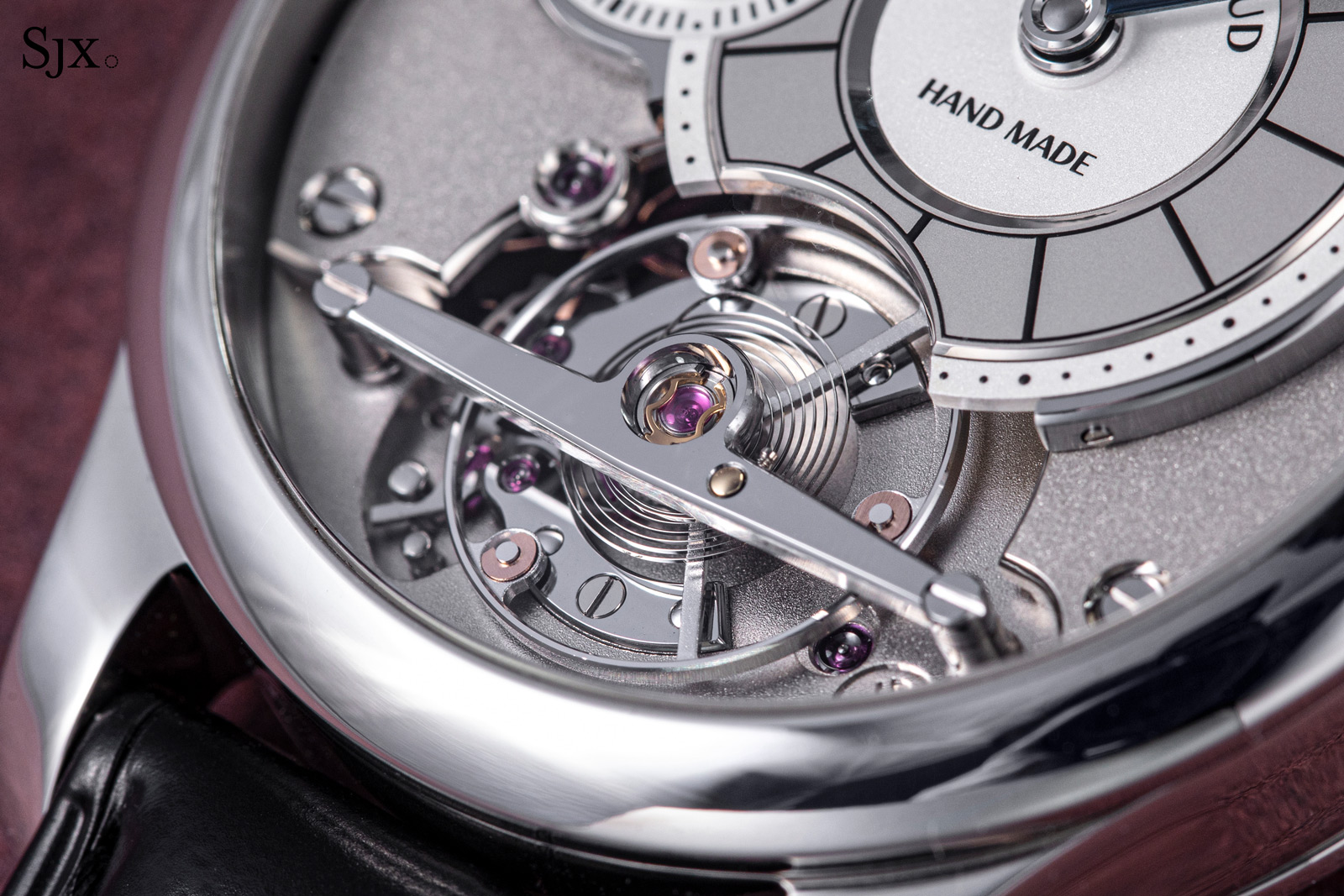
Equally impressive are the twin bridges under the balance wheel for the escape wheel and pallet lever. Both are similarly black polished and reveal locating pins with rounded, mirror polished tops.
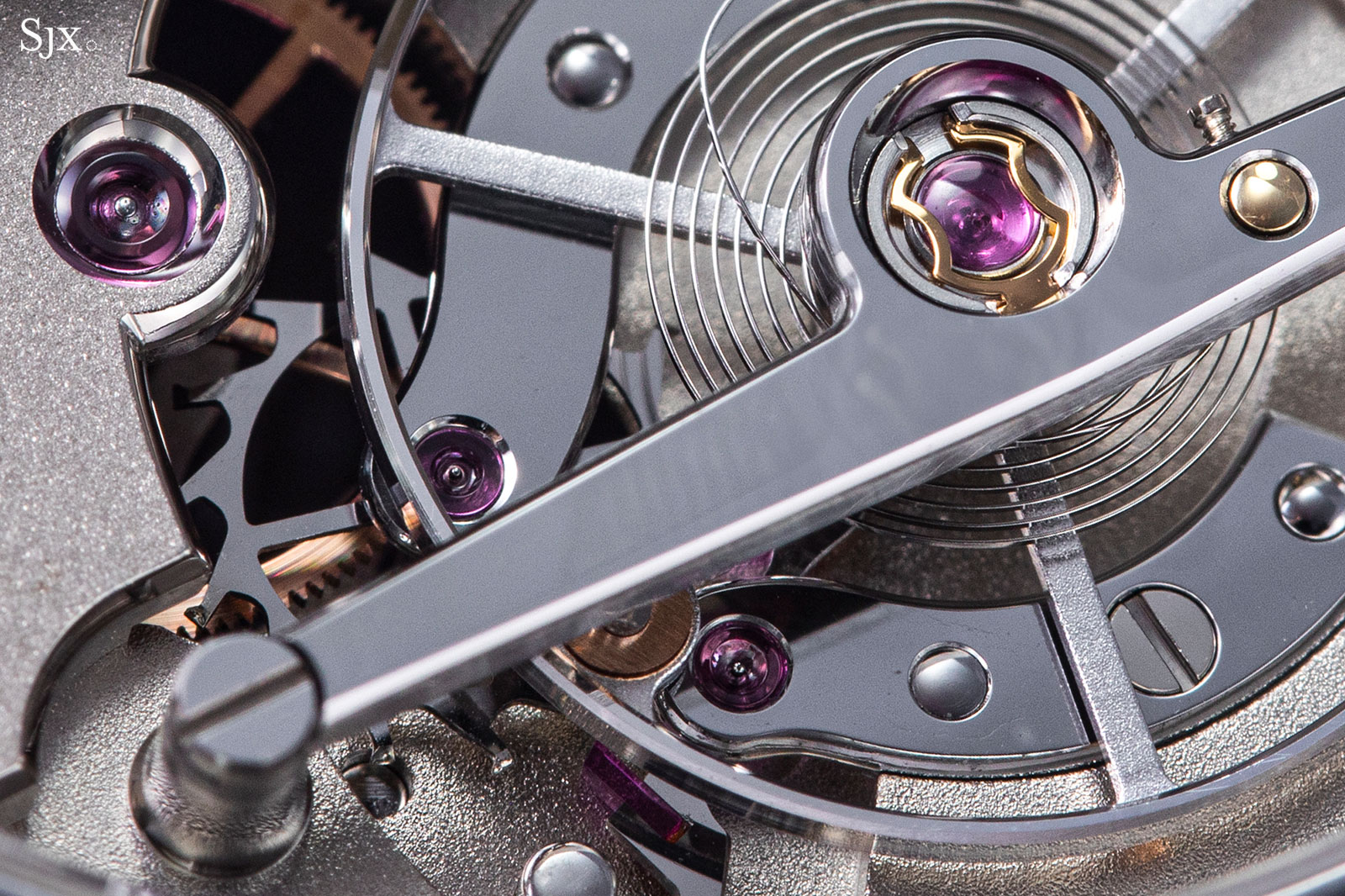
The Breguet overcoil hairspring with the twin black polished bridges underneath
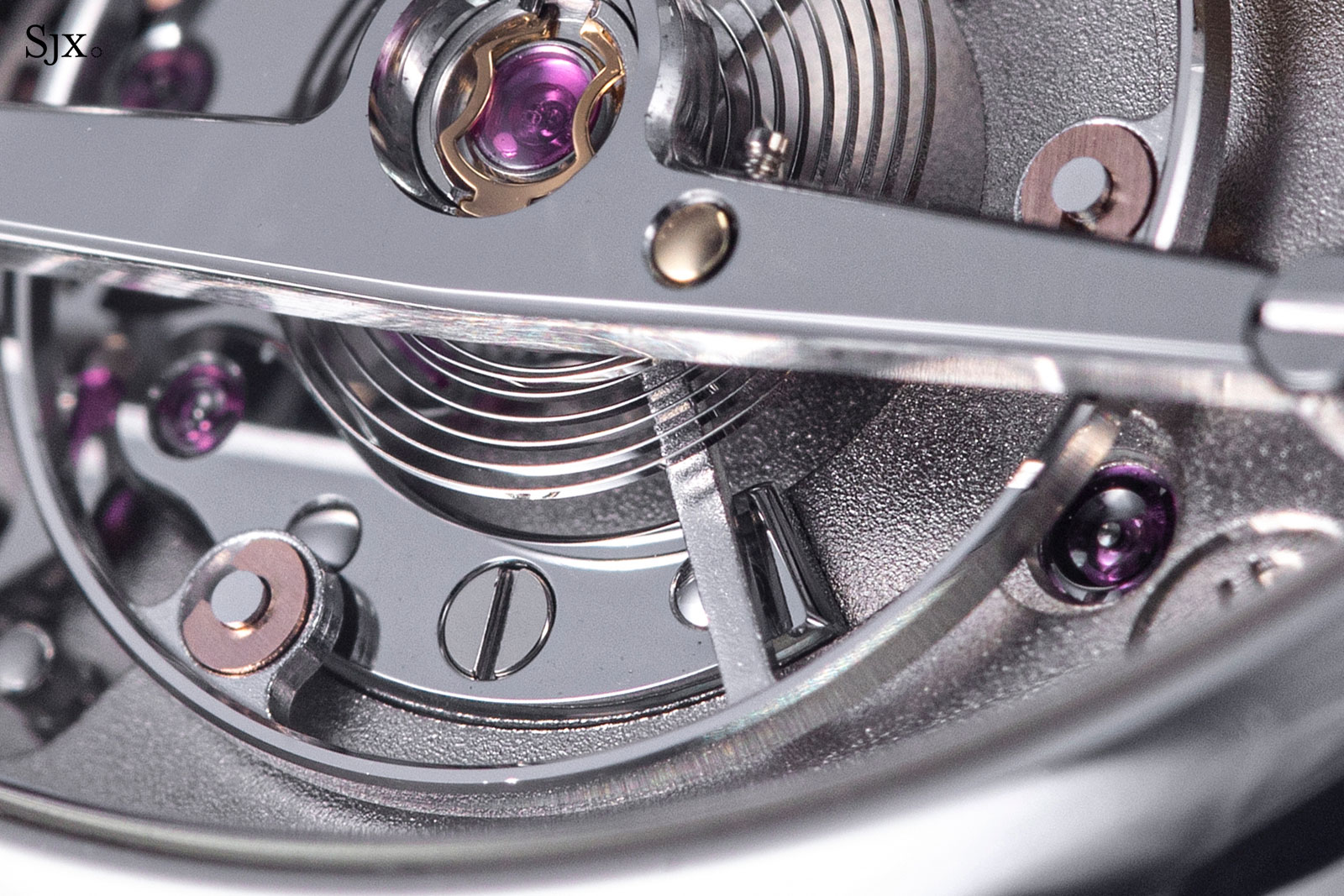
Despite being mostly hidden, the steel bridge for the pallet lever is immaculately finished
Though simple in design and small compared to the size of the movement, the dial is made up of several parts that give it texture and depth. The chapter ring for the hours is raised, as is the scale on the seconds register.
While less elaborate than the mechanical parts, the dial is also of fine quality. It’s produced by Comblemine, the specialist manufacturer owned by Voutilainen. But perhaps the most impressive element of the dial is the steel ring that encircles both sub-dials. Narrow enough that it’s mostly invisible, the ring is black polished and bevelled along its lengthy edge.
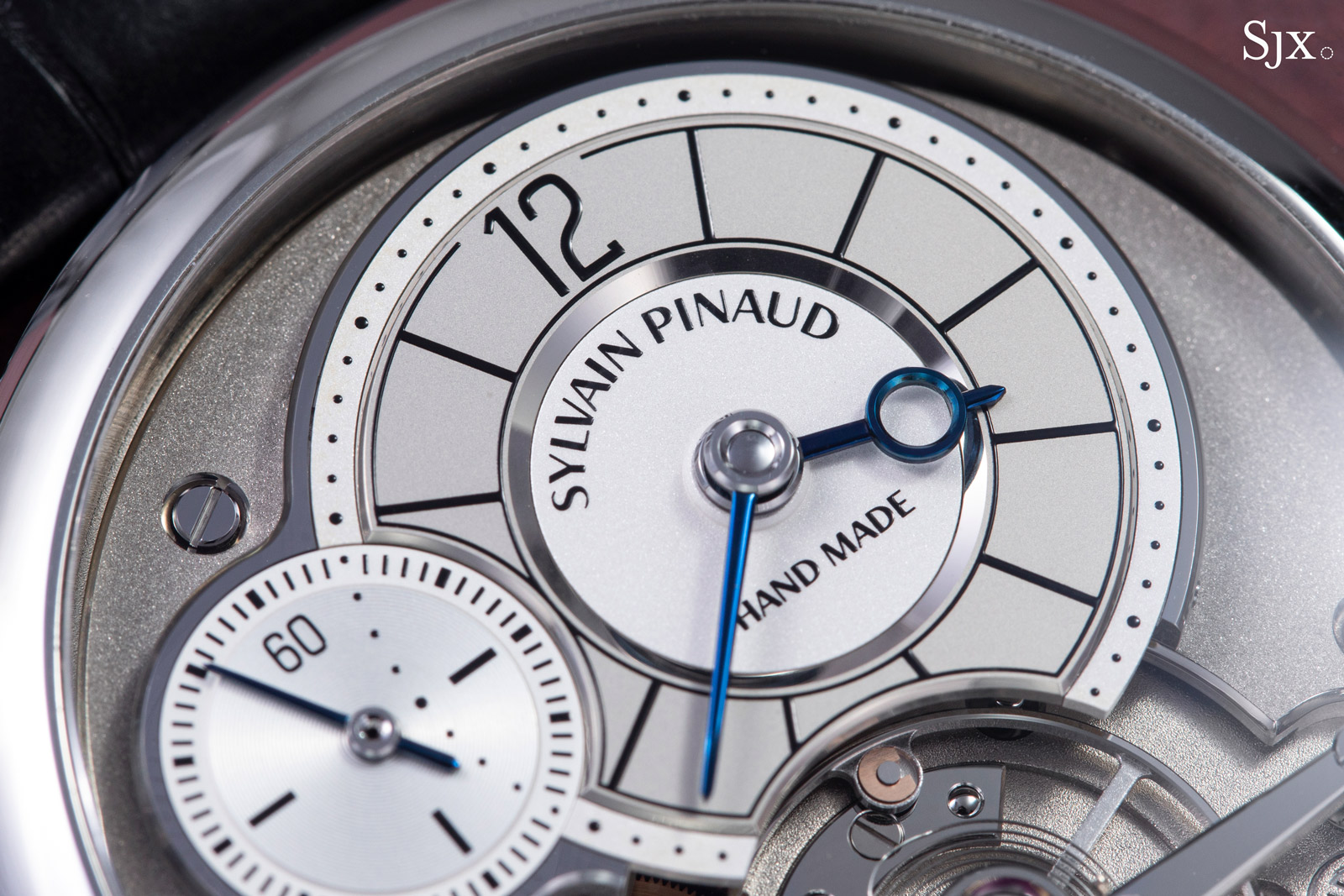
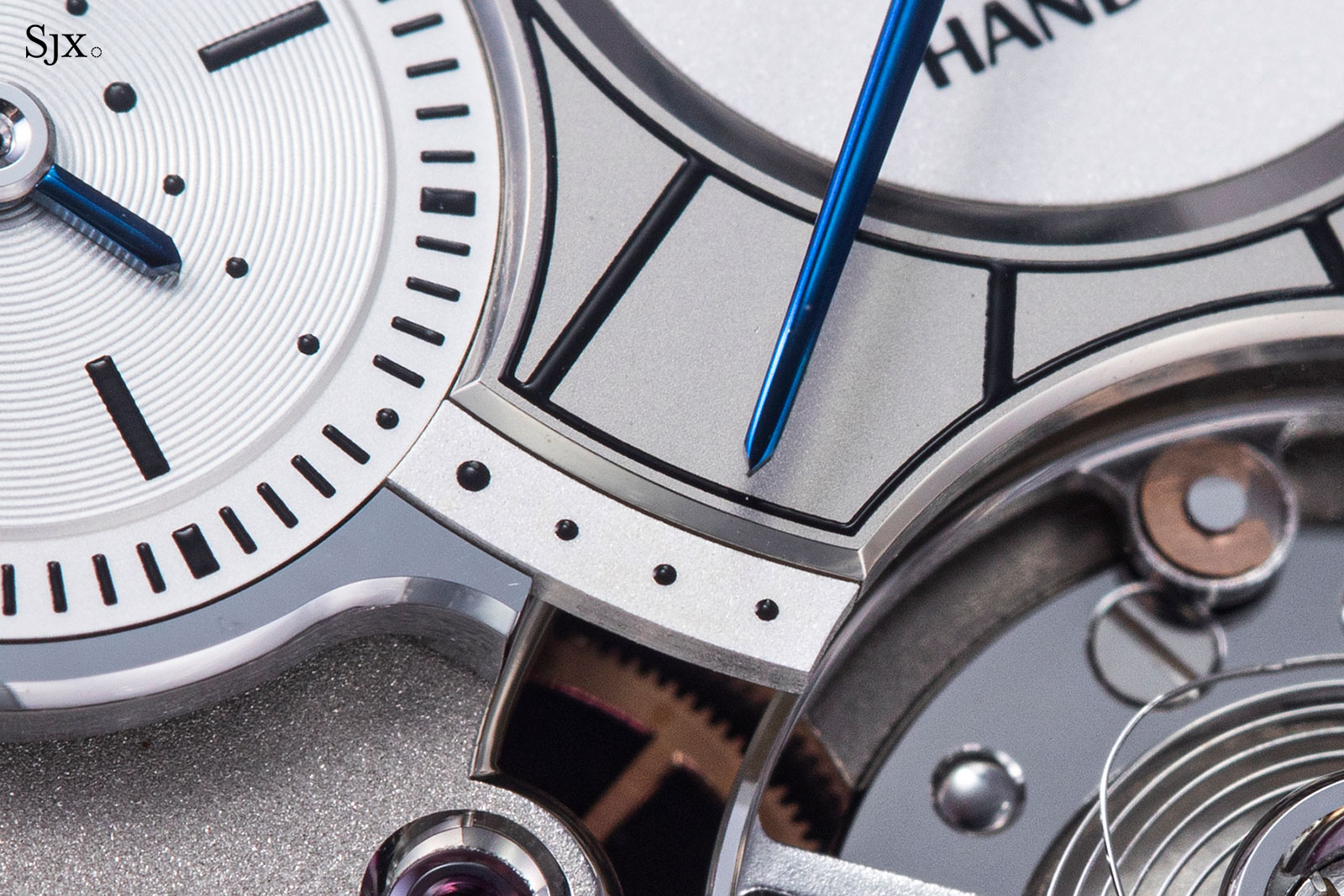
The printing on both sub-dials is impressively precise, while the end of the steel ring (lower left) shows off its perfect finishing
The hands, however, are made by Mr Pinaud’s workshop. They are blued steel, mirror polished, and chamfered on the requisite edges.
Both hands are done perfectly from a quality standpoint, but I wish the point of the hour hand are sharper. Its tip appears rounded compared to that of the minute hand.
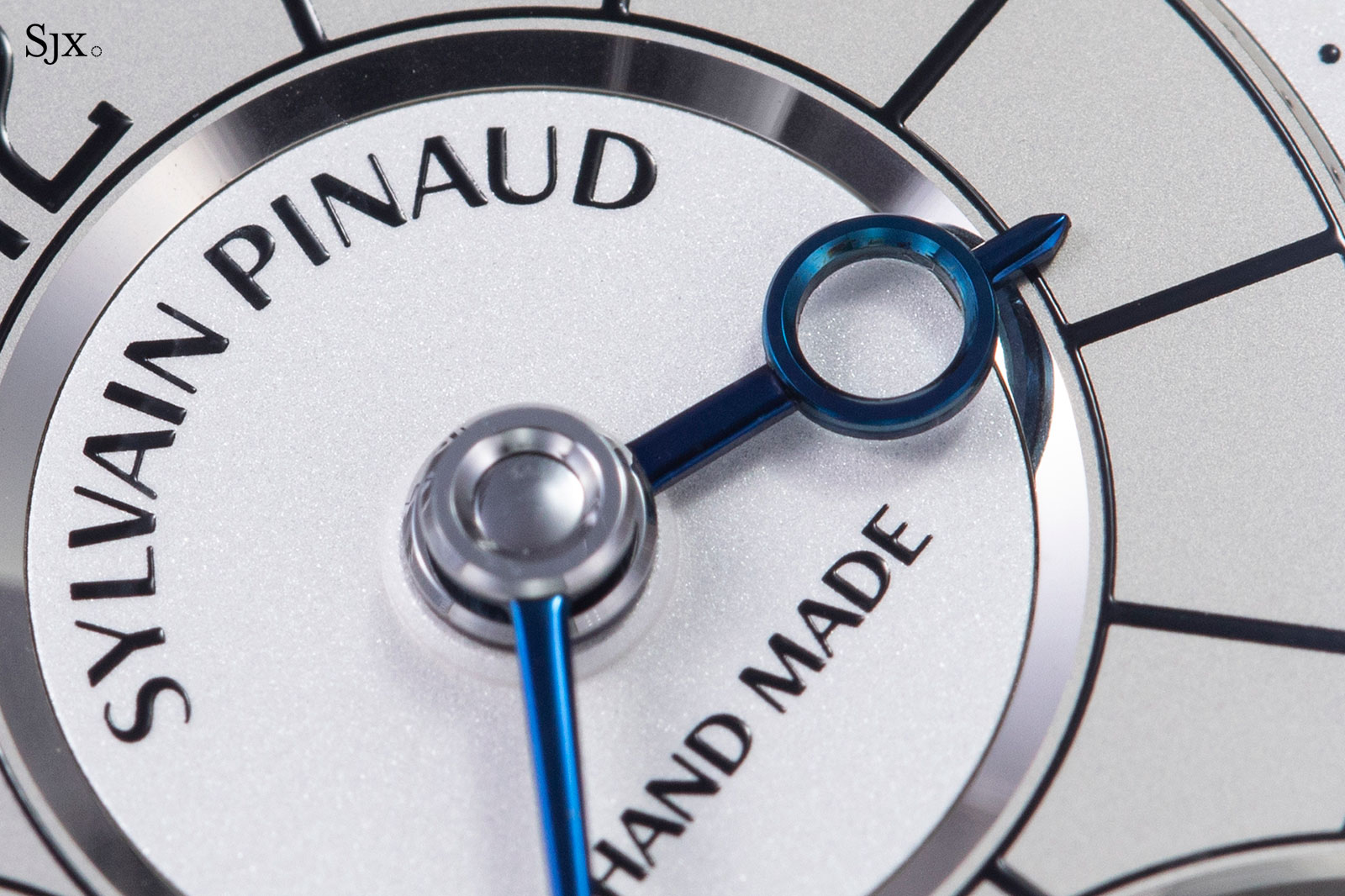
Every element on the front is so well done it is a struggle to find something to criticise. Two details, however, could perhaps be done better. One is the rounded angle between the straight and rounded edges of the balance bridge. Another is less obvious but odd: the gold weights on the balance wheel are not all identical in shape.
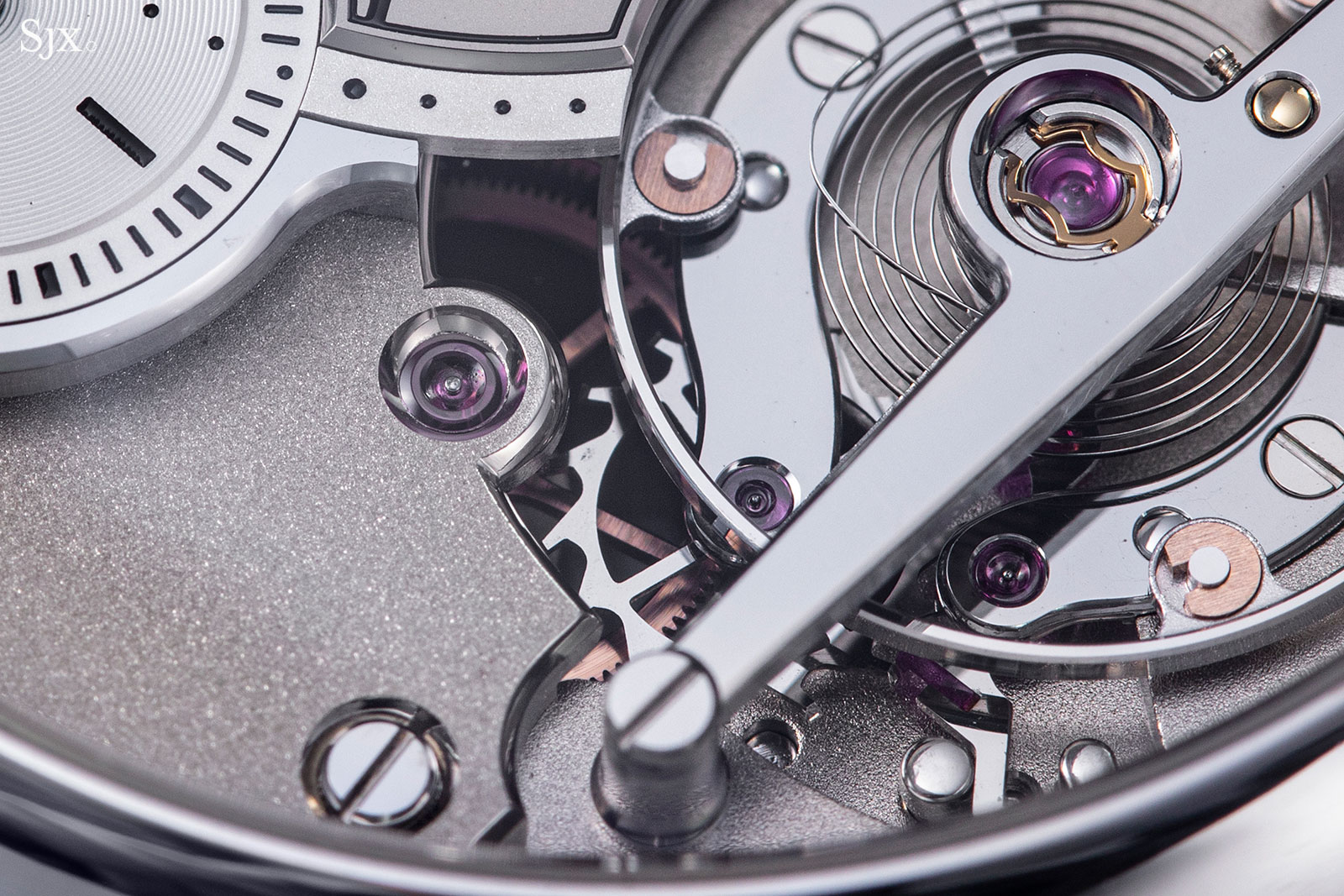
The same is true on the back – everything is done decorated perfectly. The aesthetic is still one of restrained, traditional watchmaking that’s finished finely but discreetly.
Except for the absent balance and escapement, the layout of the movement is traditional with a large barrel bridge and finger bridges for the going train. Finished with sandblasted frosting, the bridges are shaped to maximise the decorative details. As a result, they incorporate many sharp angles along their bevelled edges.
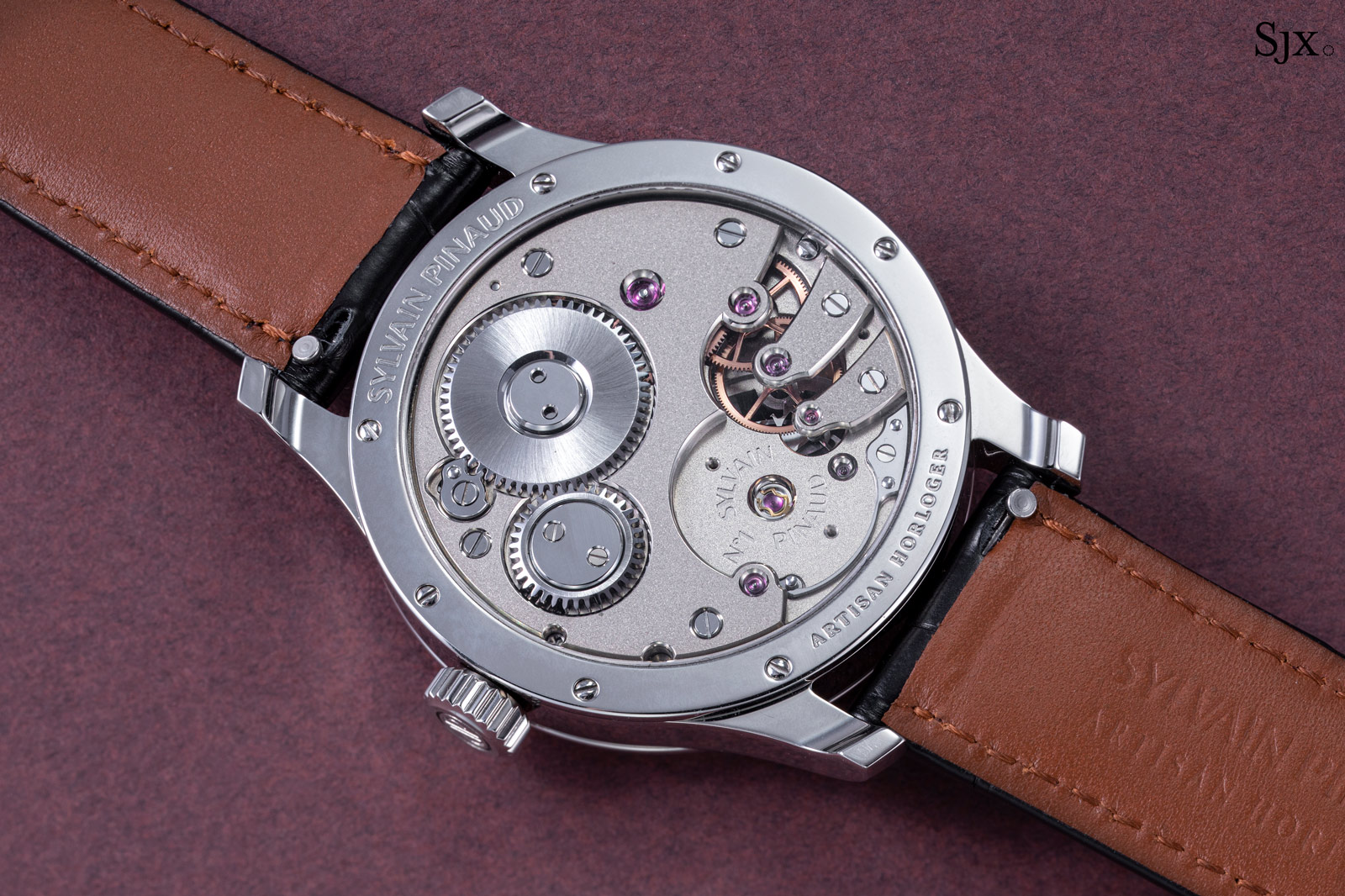
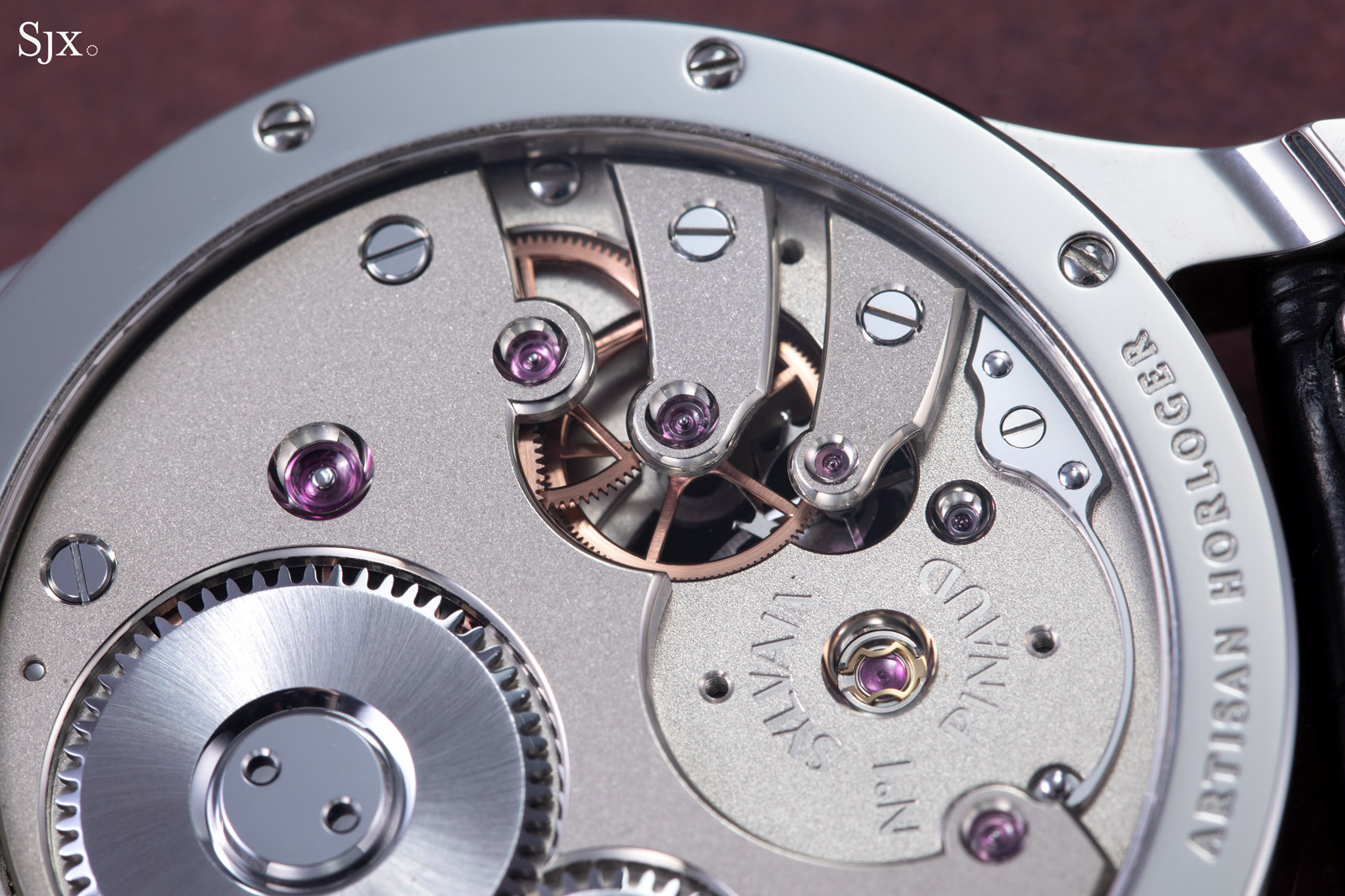
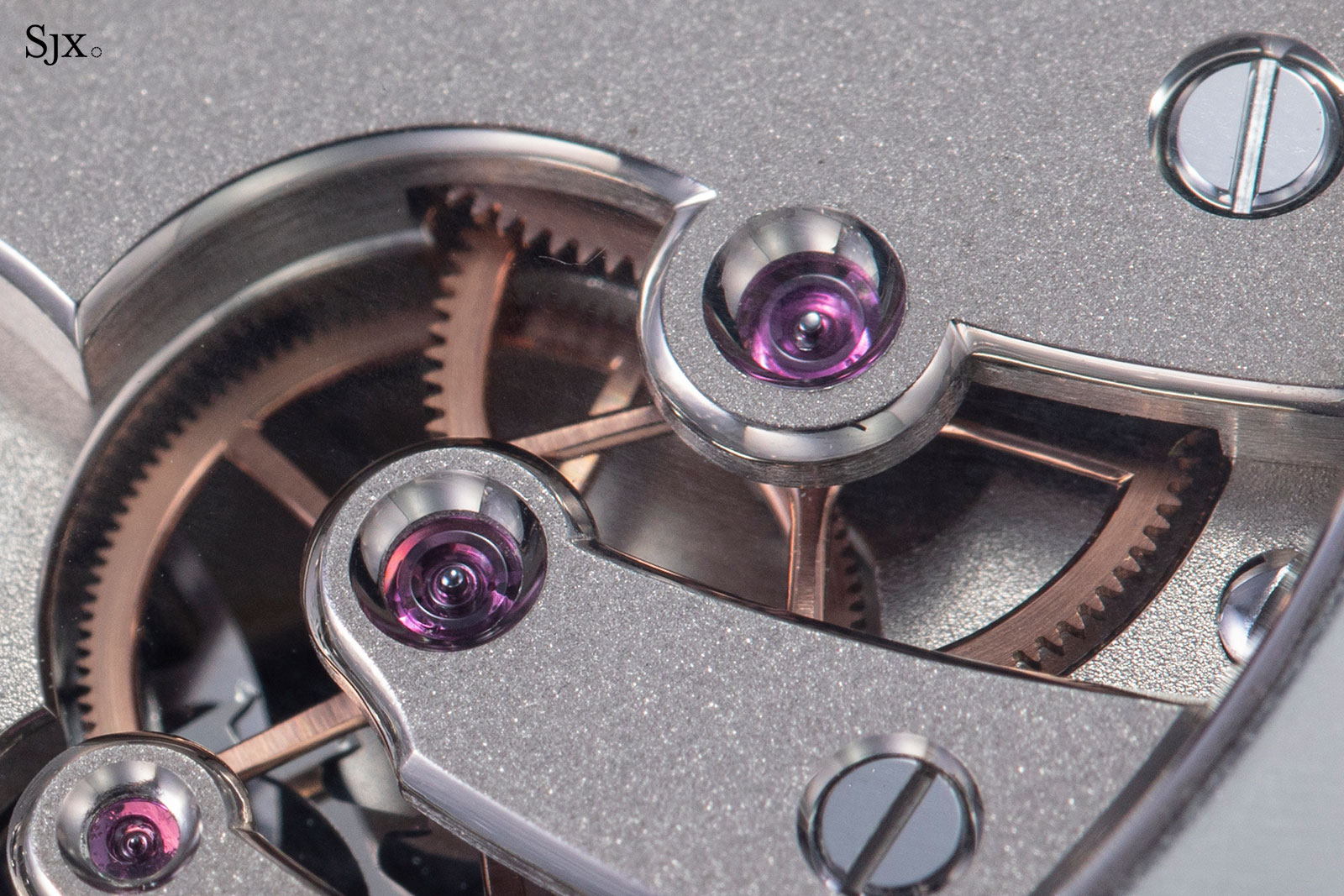
All of the gears have circular grained faces along with chamfered inner edges and spokes
Notably, the steel wheels are especially beautifully. The crown wheel is black polished while the two-part barrel ratchet wheel is “solar” grained while the separate central hub is black polished. And next to it is the black polished winding click.
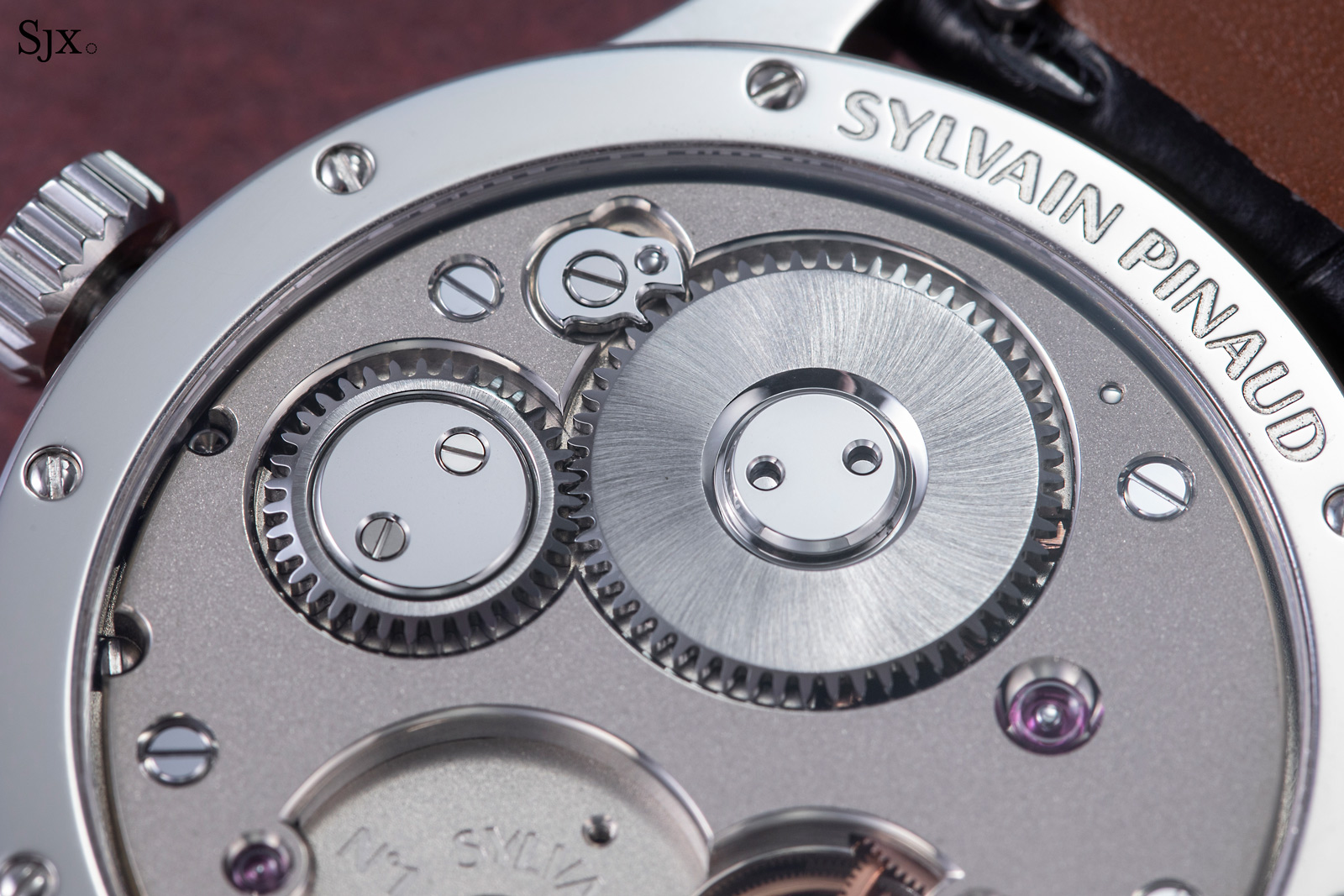
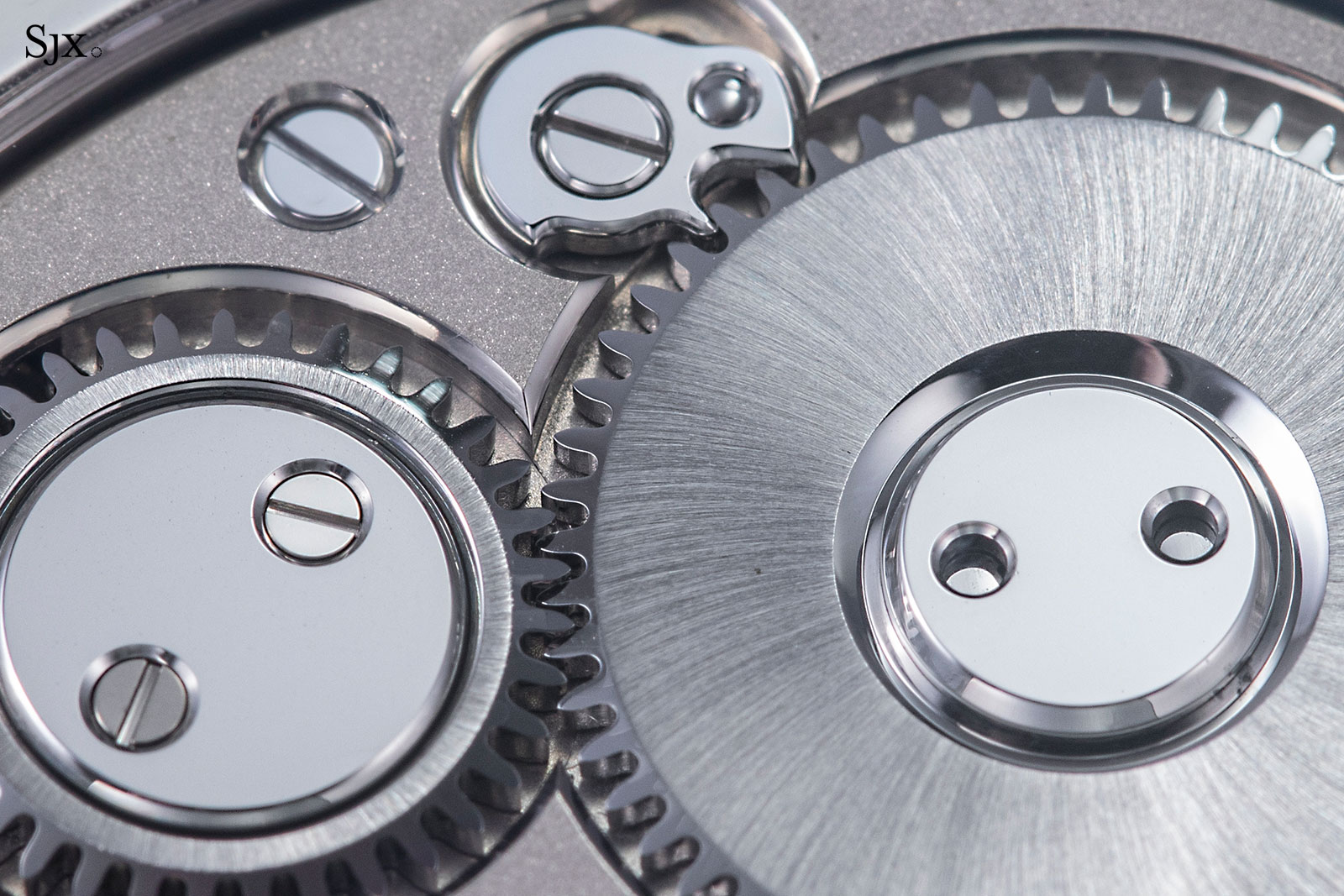
The two-part ratchet wheel is made up of a polished hub to secure the wheel, a more elaborate construction than a conventional one-piece wheel
The only criticism I have is the space where the brand and serial number are engraved. Because it appears to be a conventional aperture on the base plate for the balance wheel – after all, the barrel bridge curves around it – it feels odd that it’s empty, at least mostly.
Off to the side of the aperture is a slender tension spring for the hacking mechanism hidden under the dial. Like the other steel parts, it is black polished and chamfered.
When the crown is pulled out to set the time, a lever swings forward to stop the balance wheel, which also stops the seconds hand. The spring applies tension to the pivot of the hacking lever in order to give it a crisp, smooth action.
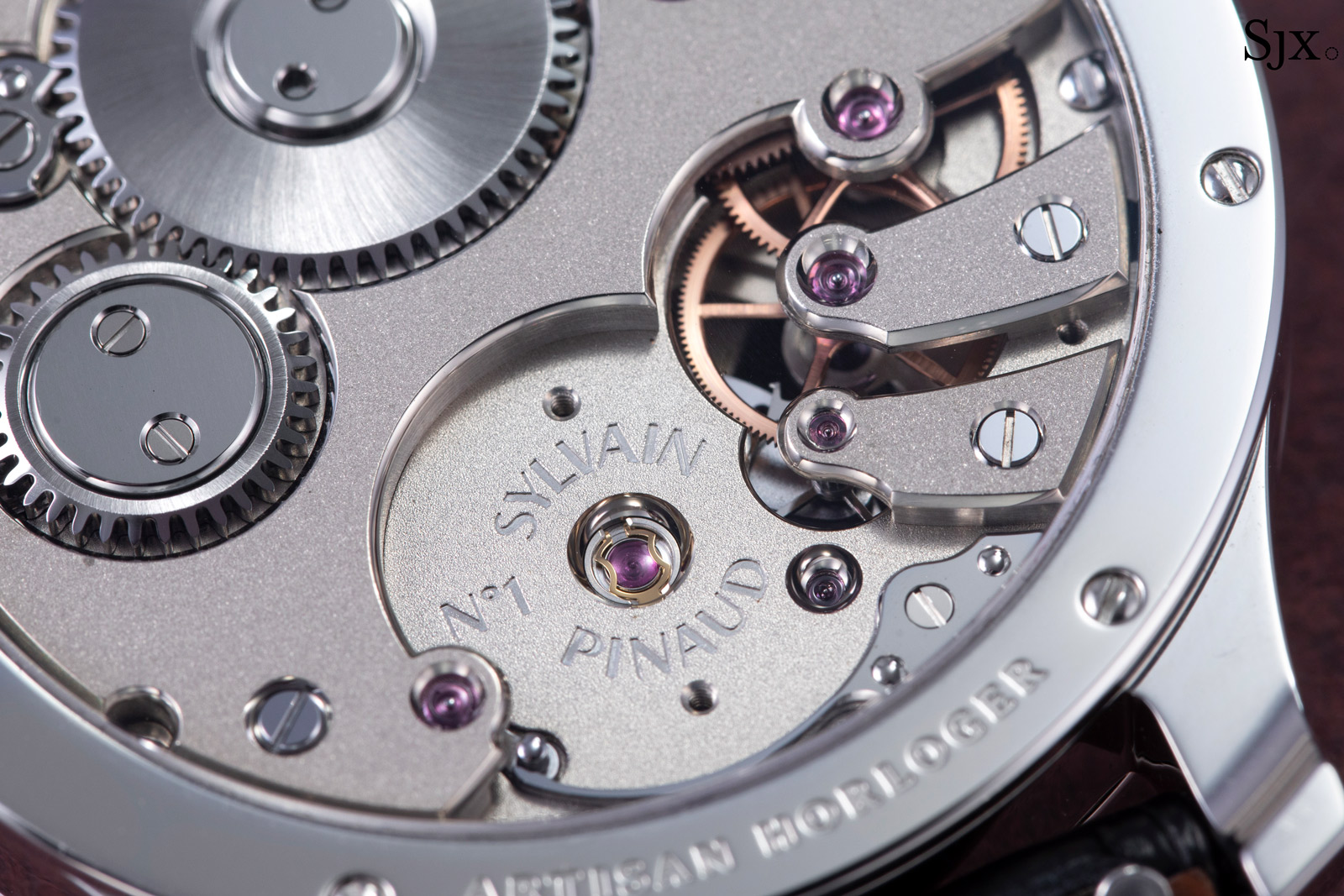
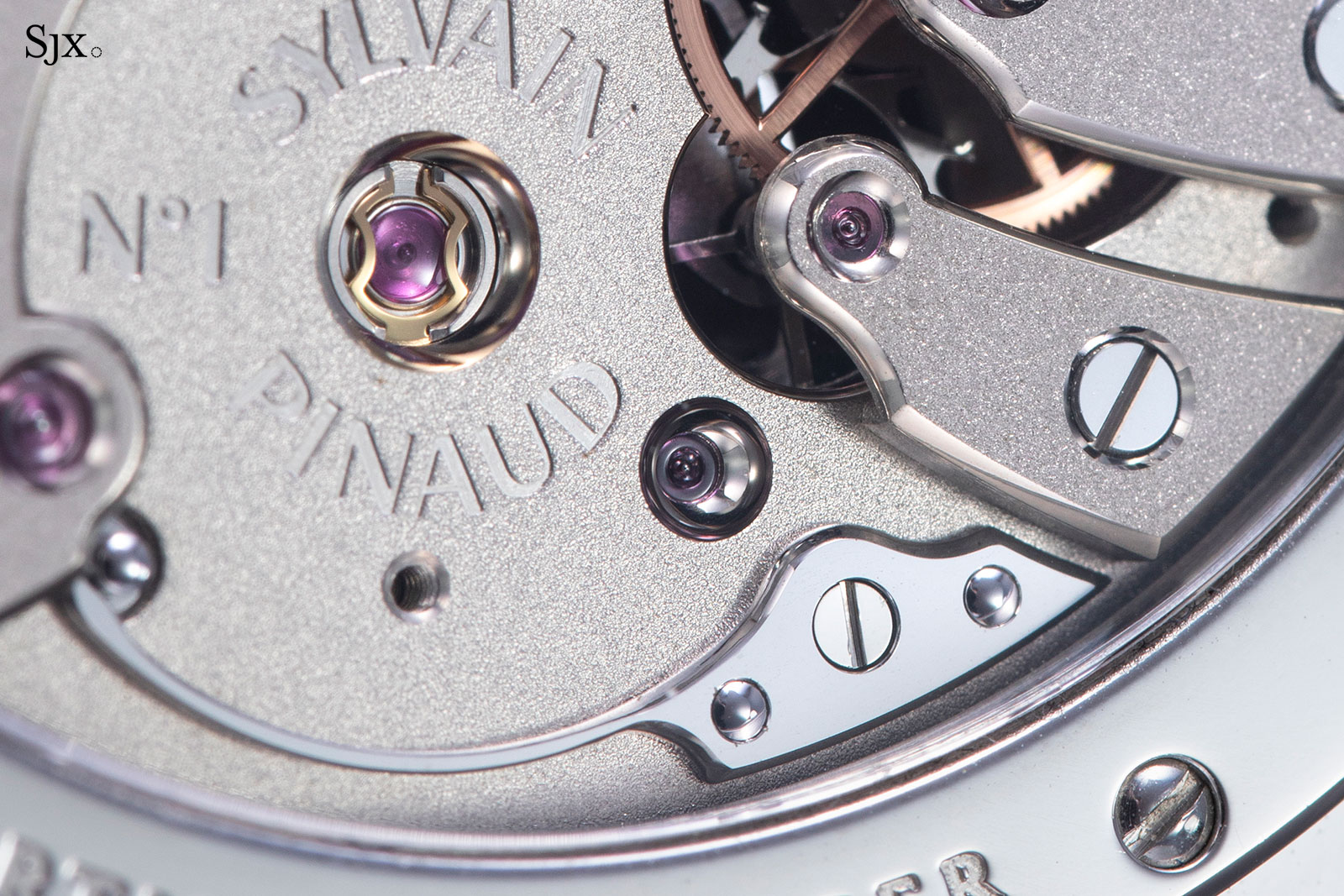
The black polished tension spring secured by one screw and two pins
However, a detail worth pointing out here is that the brand and serial number are both engraved in the same sans serif font as the dial and case back, which gives the typography a pleasing consistency. “Artisan Horloger” on the case back is in a different, serif font, but it is acceptable since it’s the brand’s motto.
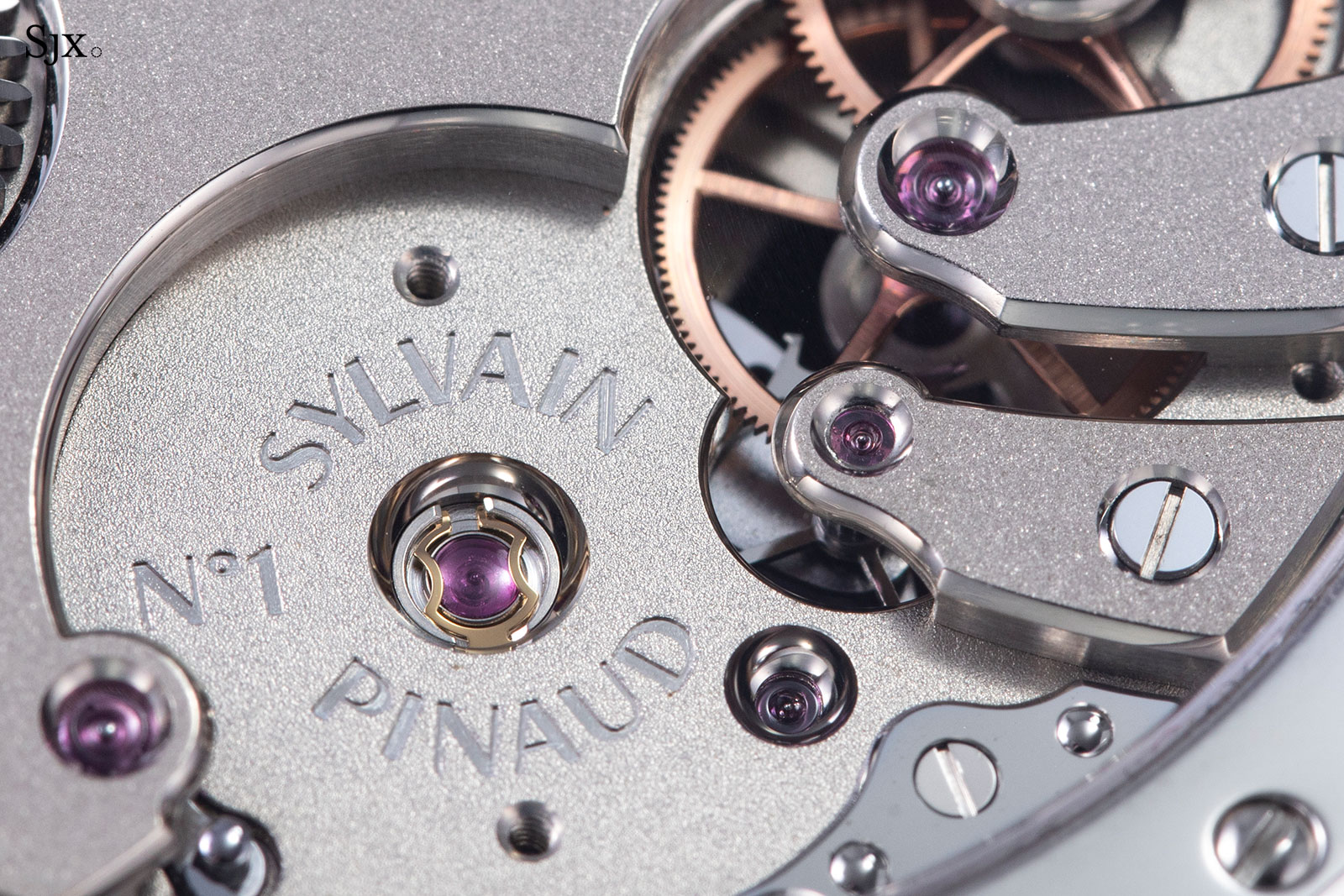

Concluding thoughts
The Origine is attractive but ordinary in terms of design, but its quality is marvellous. It’s a very strong start for a newcomer, albeit one who’s been practicing the craft for two decades.
Finishing aside, he has already gotten much of the rest right – original construction, in-house production as far as possible, high-quality and reliable suppliers, as well as direct distribution instead of agents. It all points towards a promising future for Mr Pinaud.
Key facts and price
Sylvain Pinaud Origine
Diameter: 40 mm
Height: 11 mm
Material: Stainless steel
Crystal: Sapphire
Water resistance: 30 m
Movement: Origine
Functions: Hour, minute, and seconds
Winding: Hand wind
Frequency: 21,600 vibrations per hour (3 Hz)
Power reserve: 55 hours
Strap: Leather with pin buckle
Limited edition: No
Availability: Direct from Sylvain Pinaud
Price: CHF65,000 with steel bridges and blue hands, CHF68,000 with rose gold hands and bridges (prices exclude taxes)
For more, visit Sylvain-pinaud.com.
Back to top.

